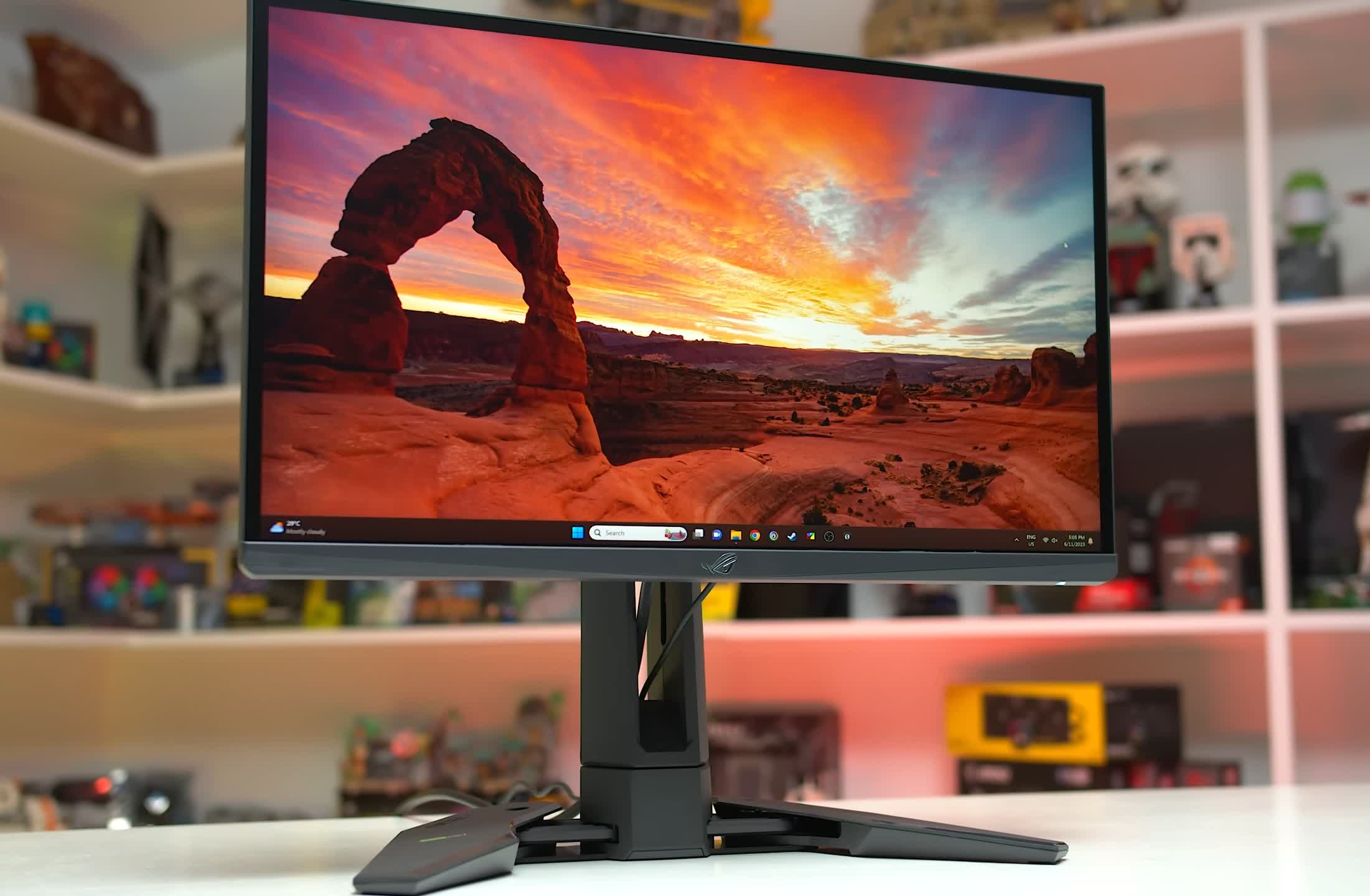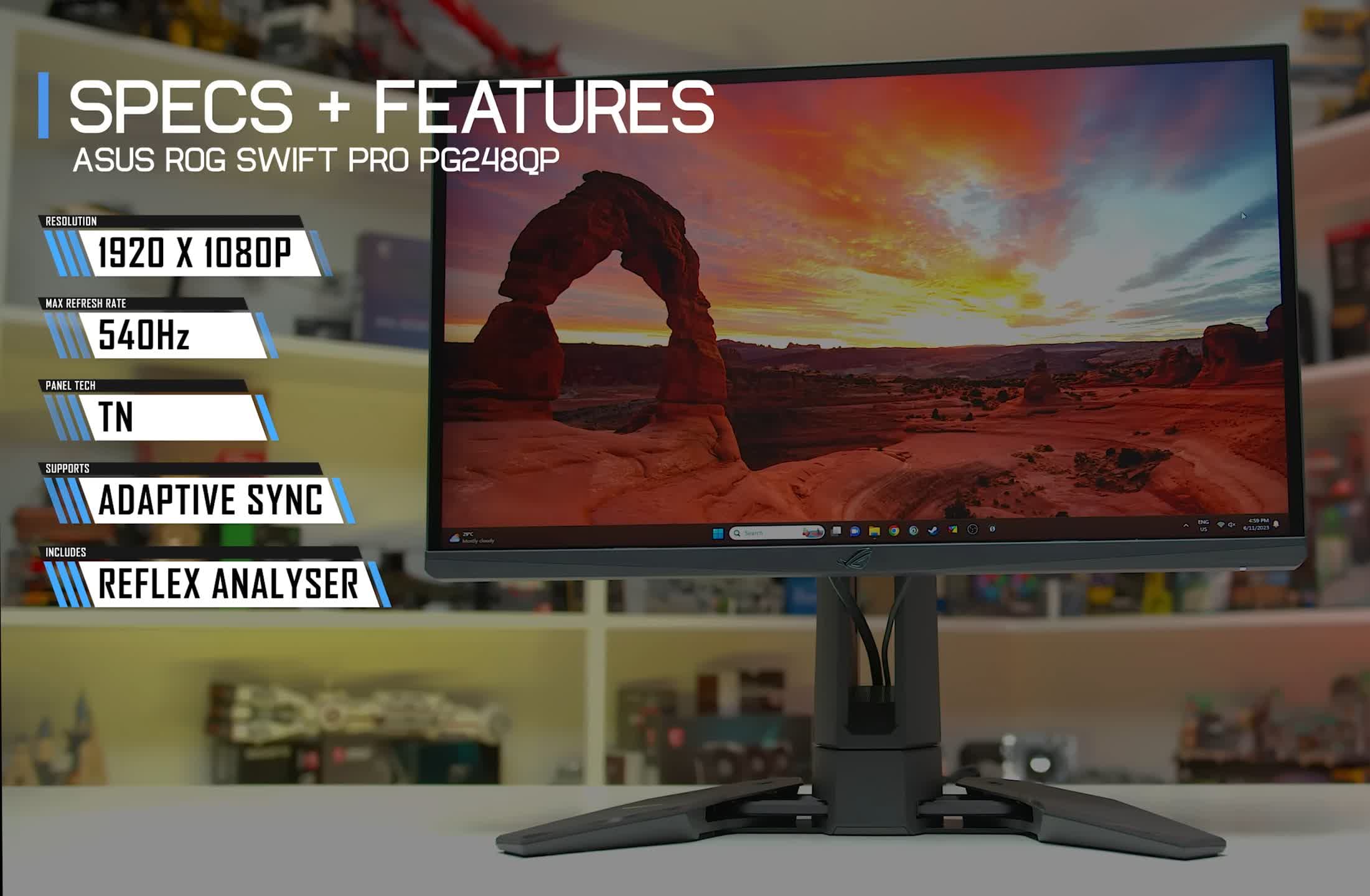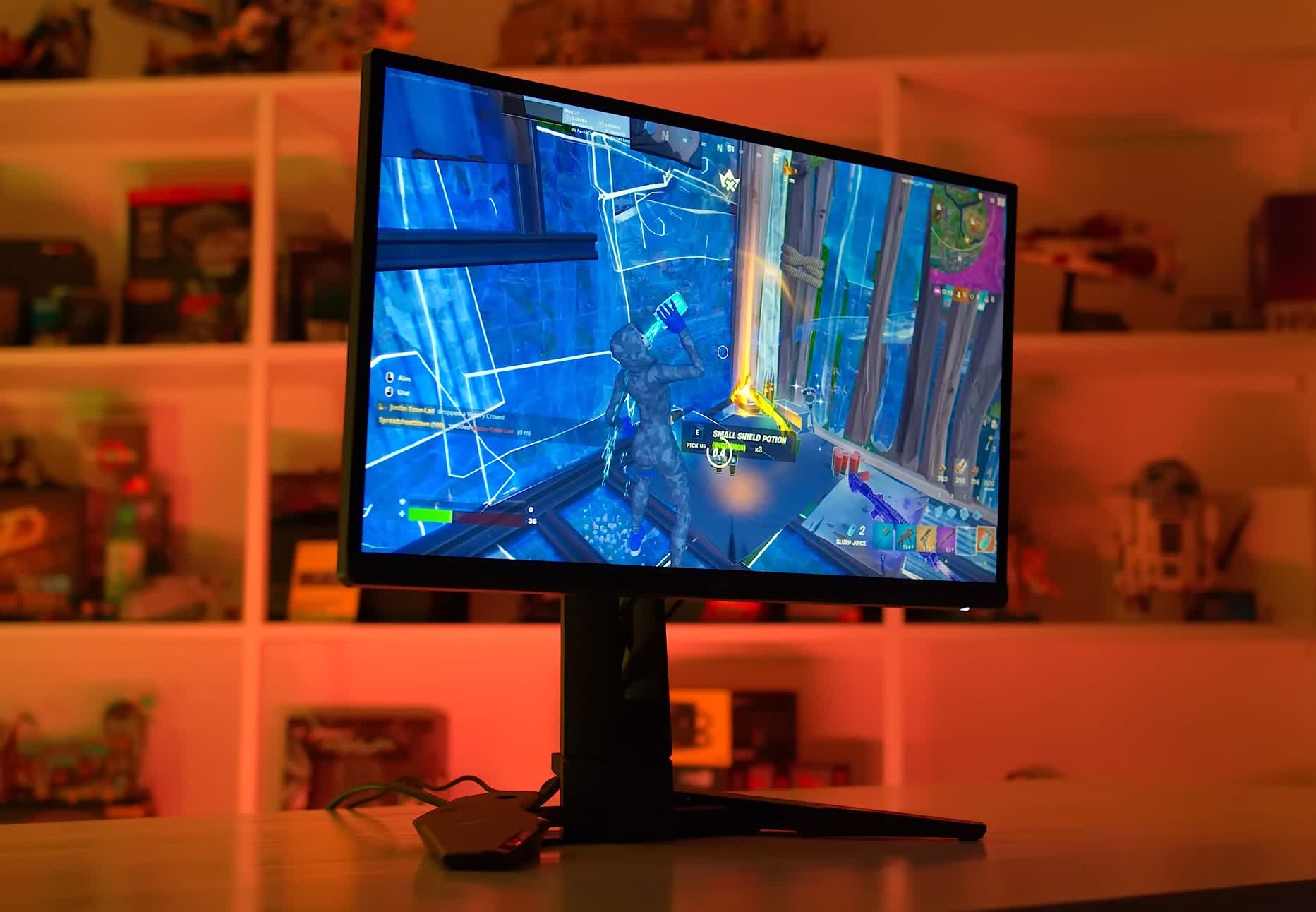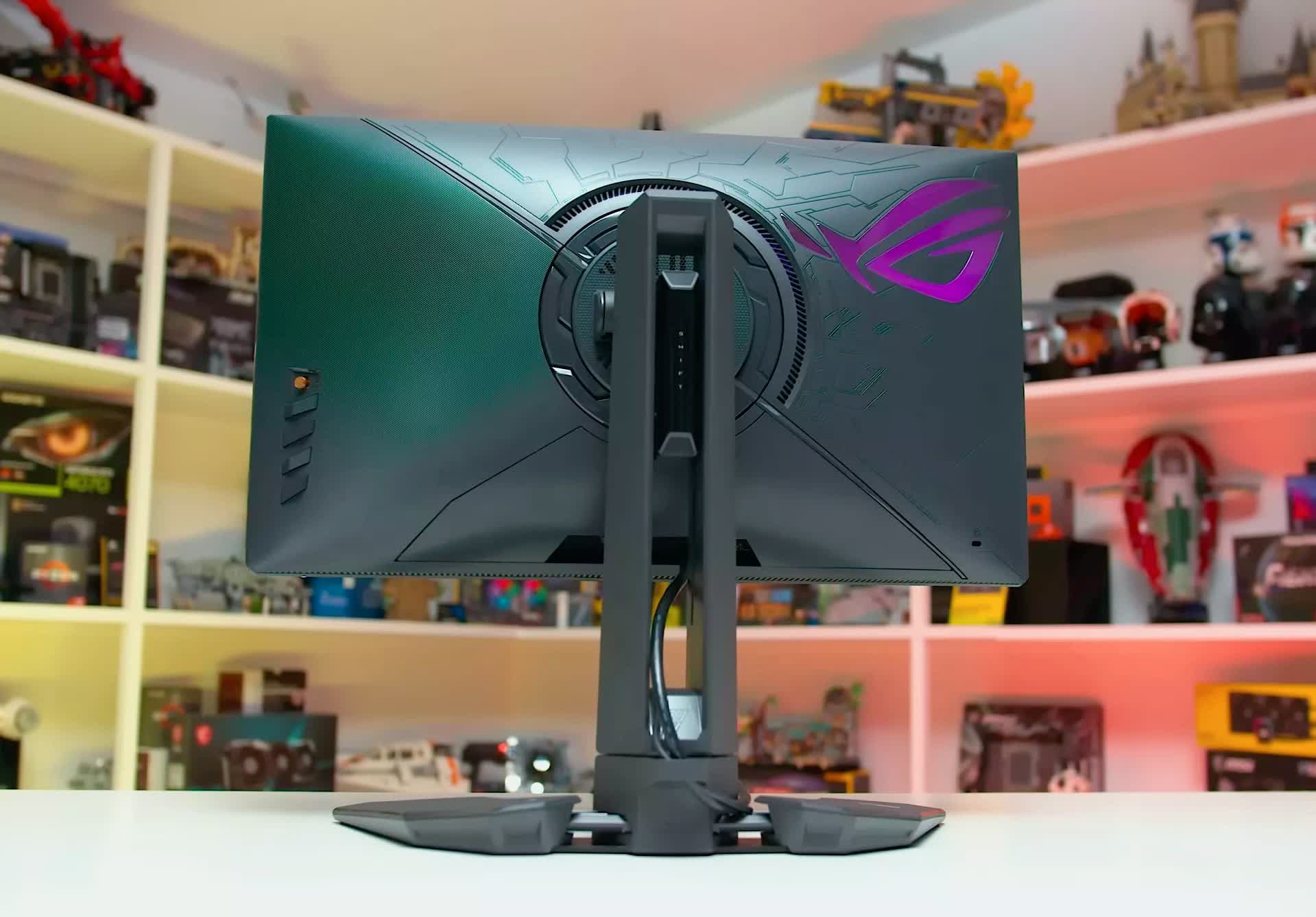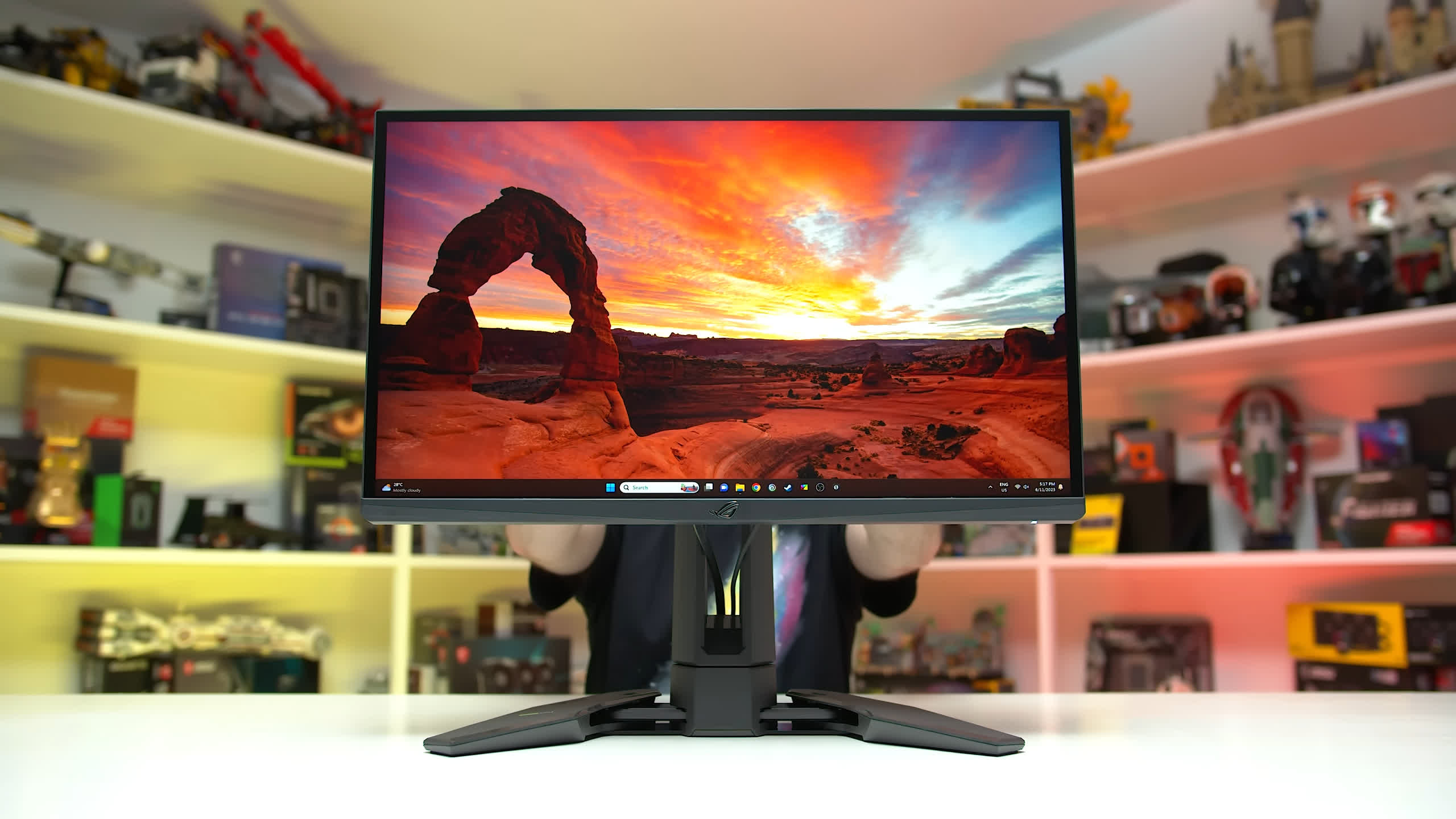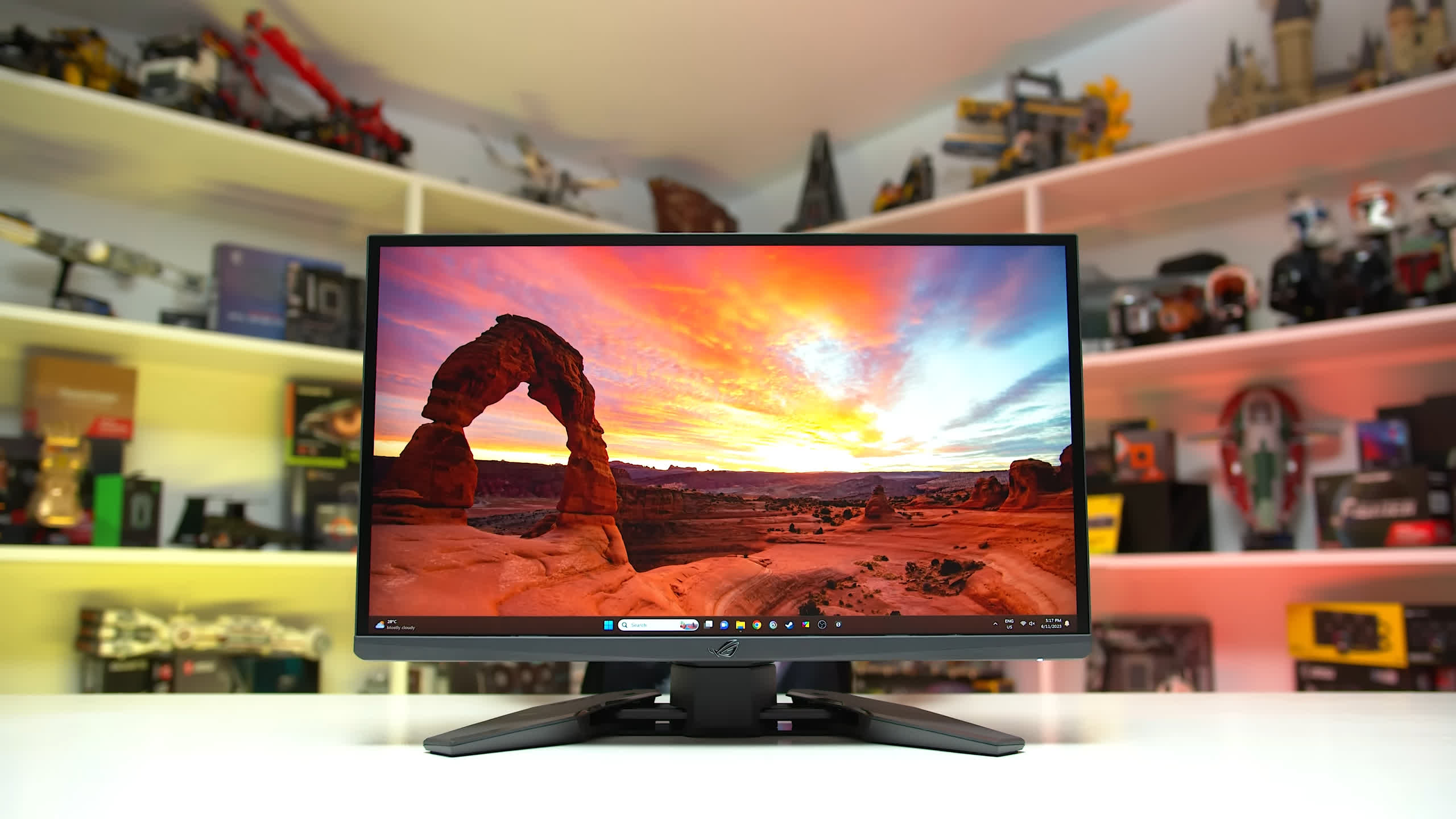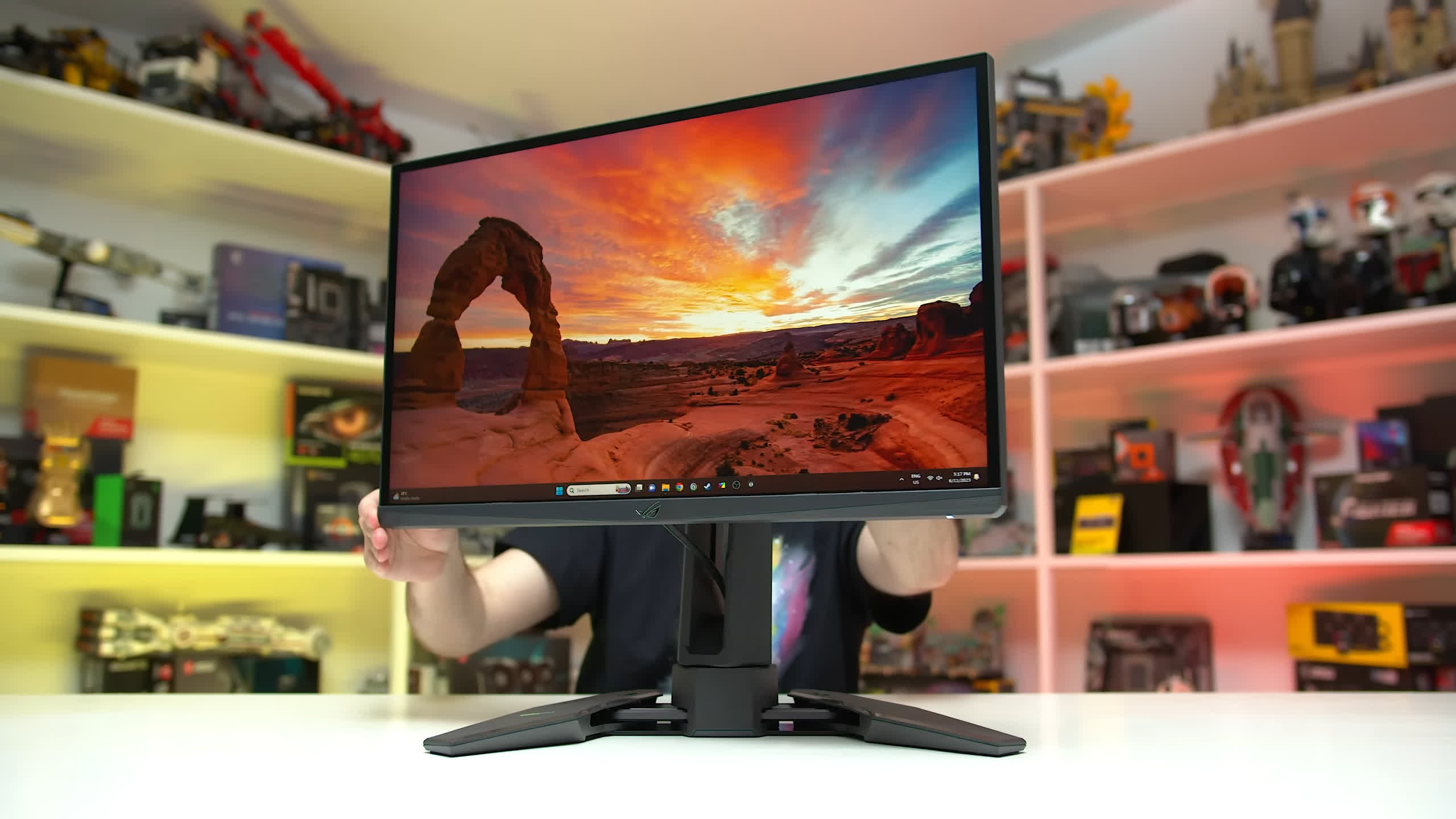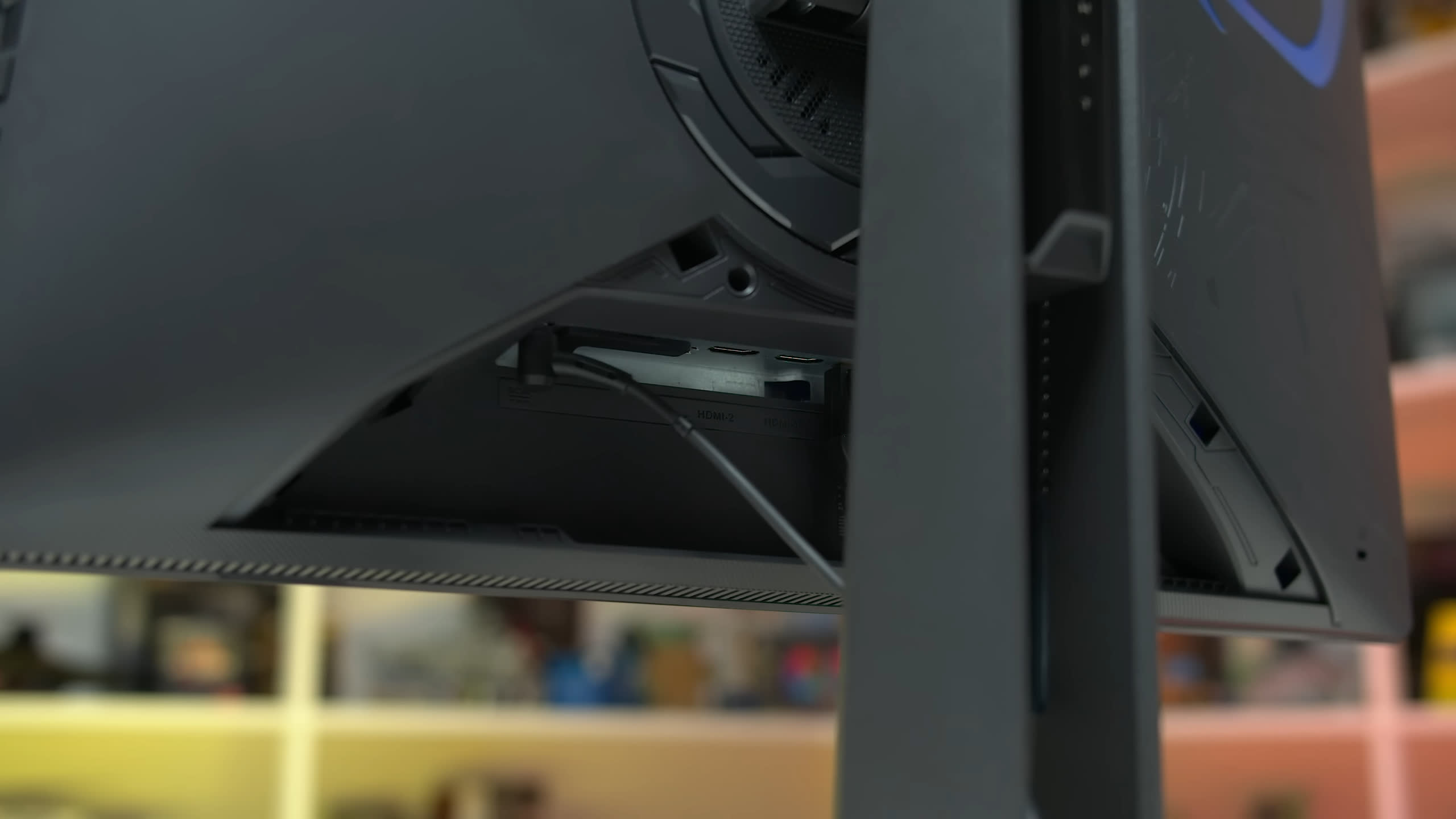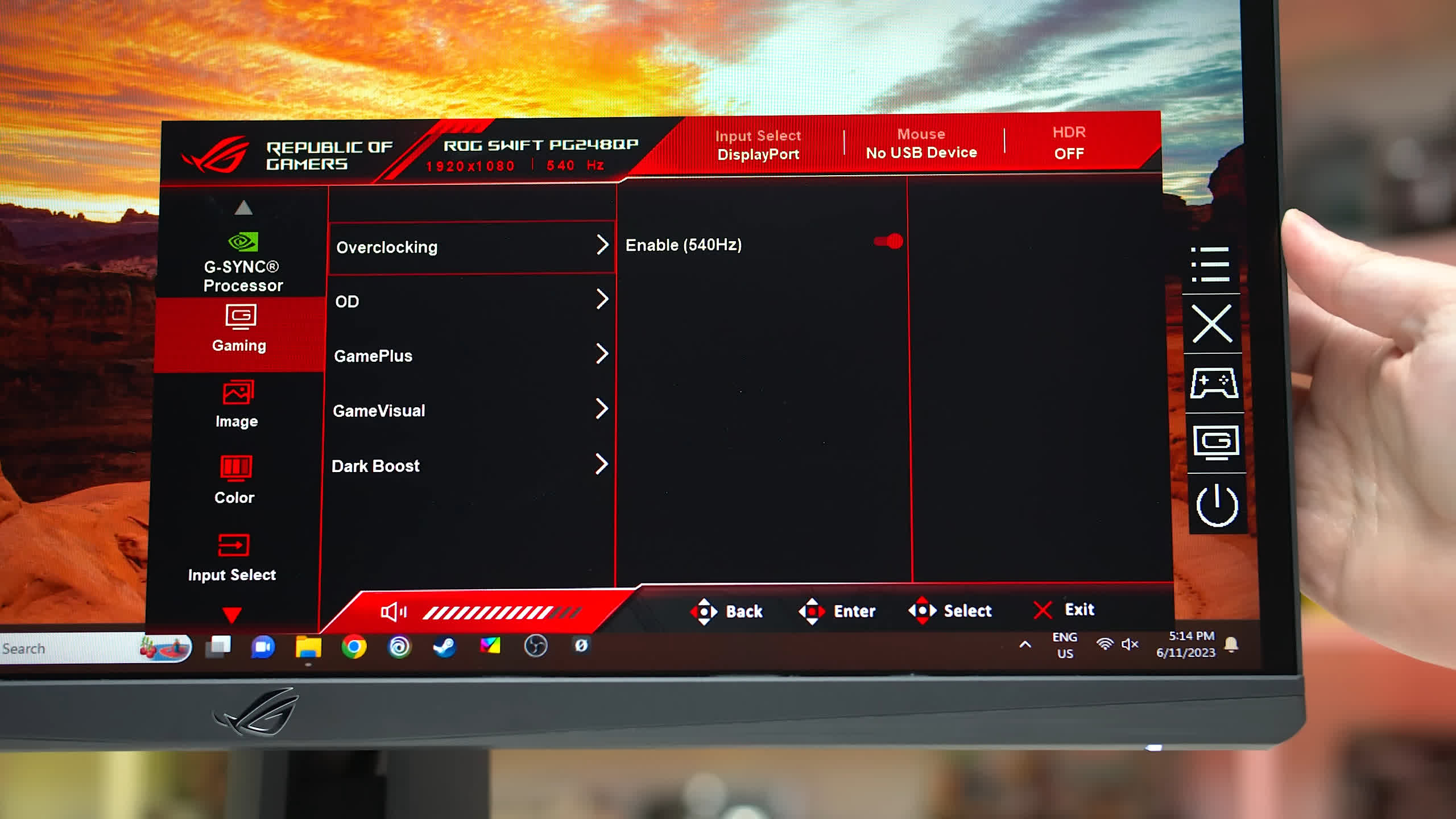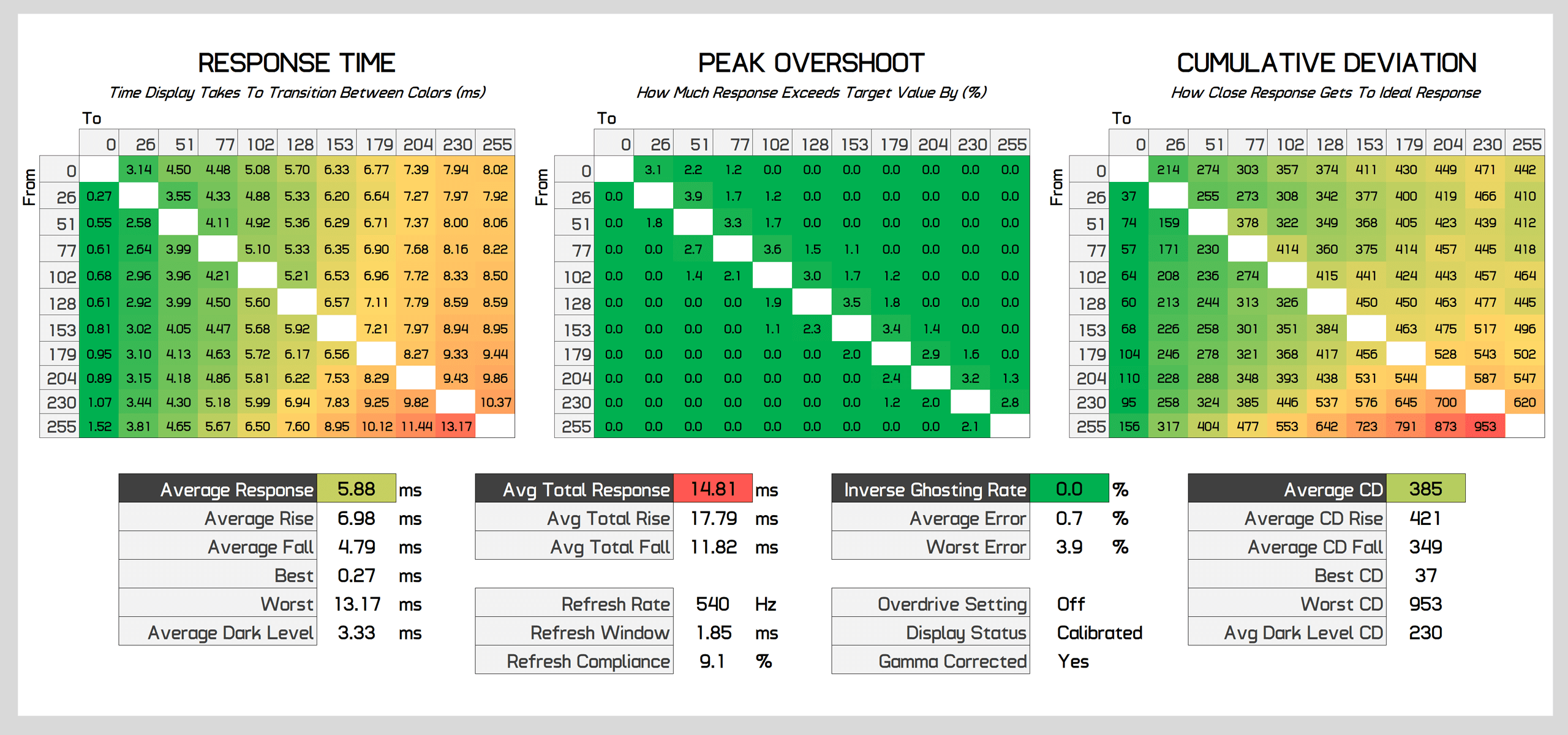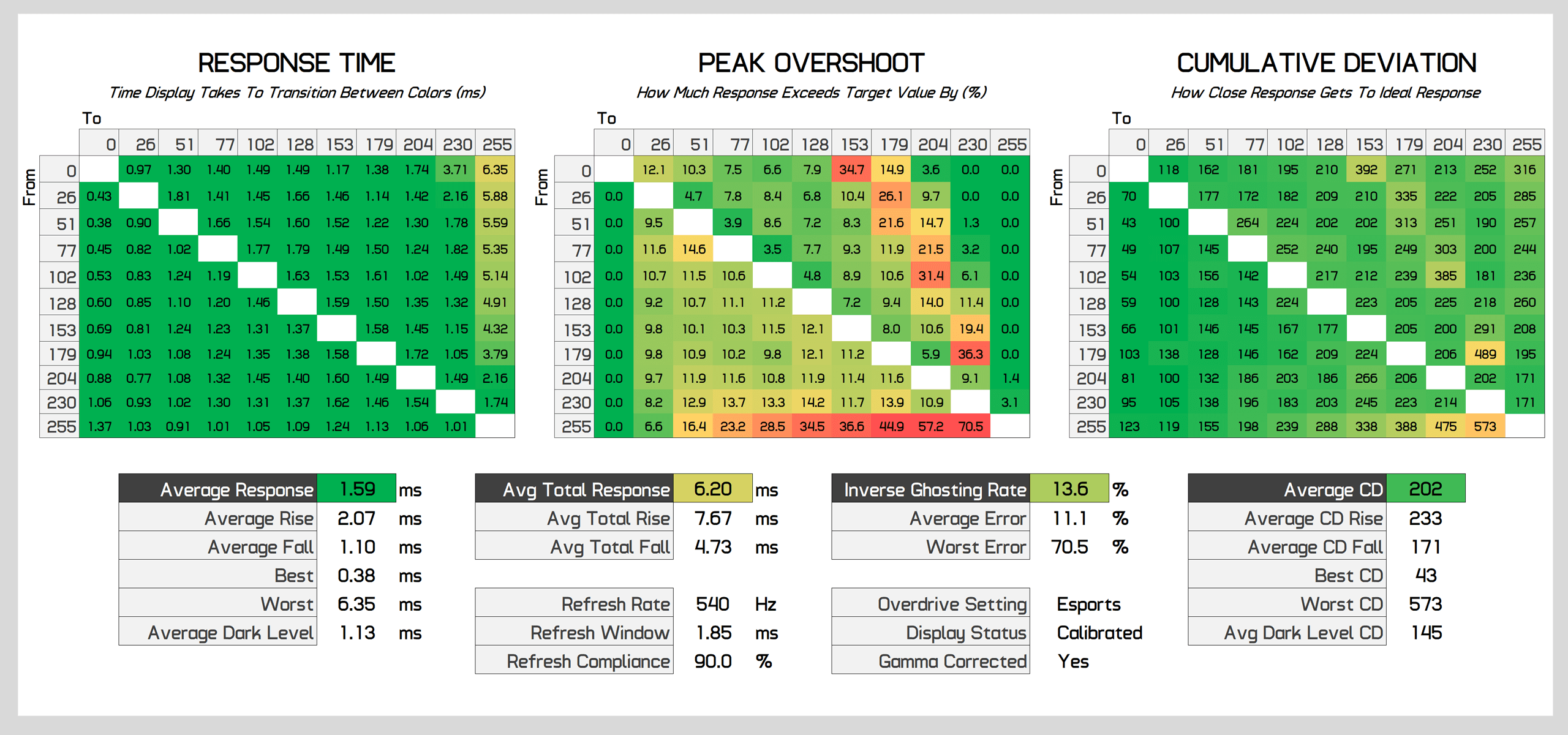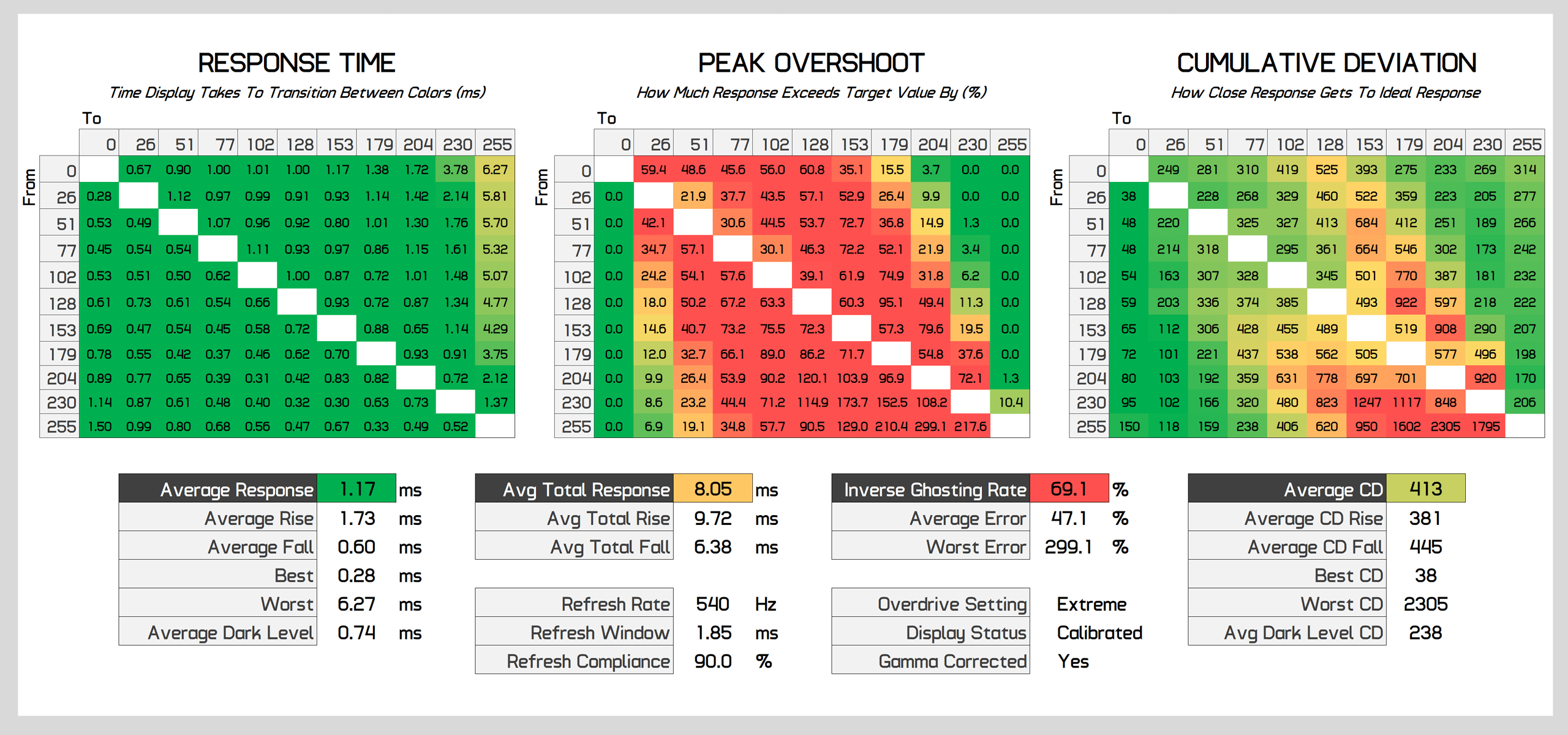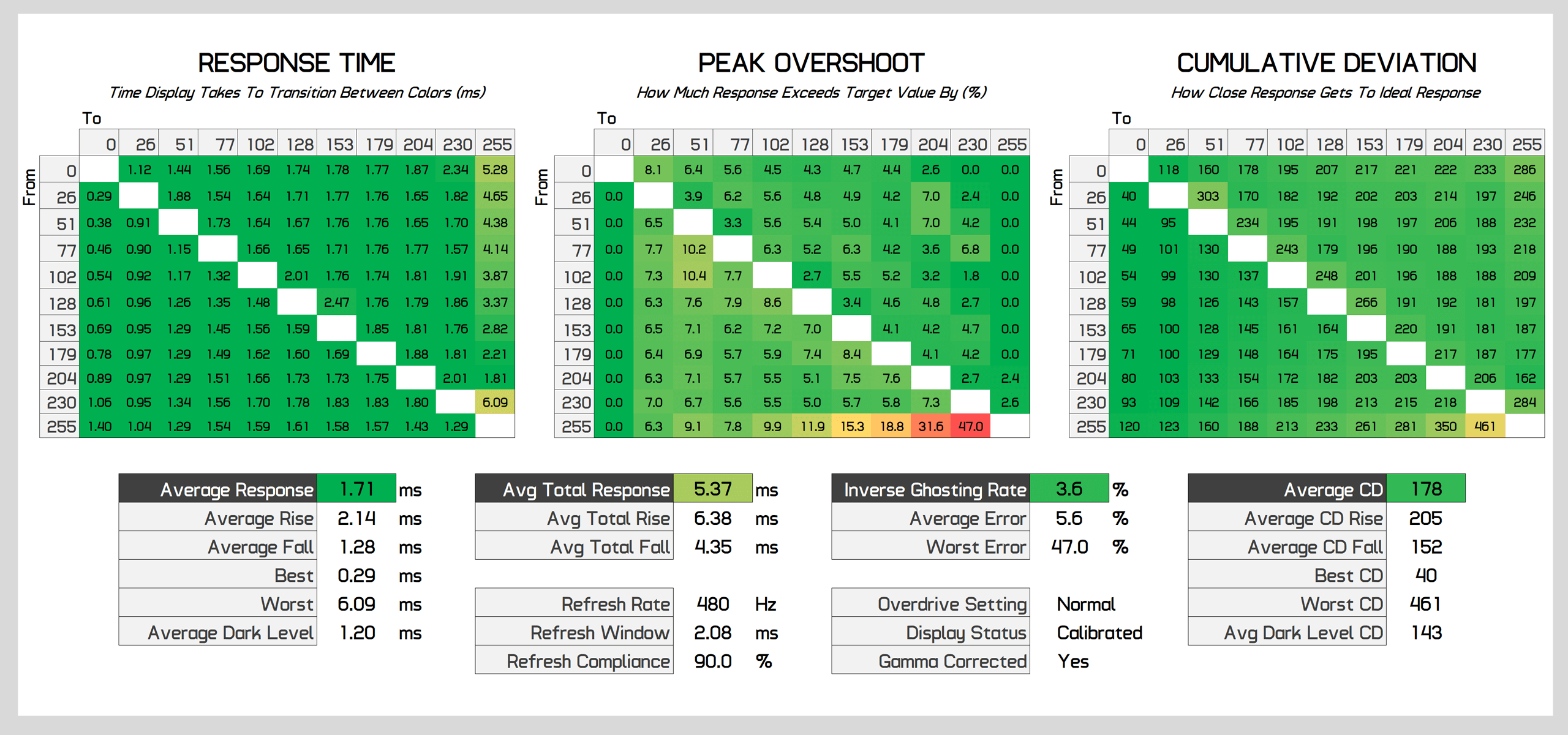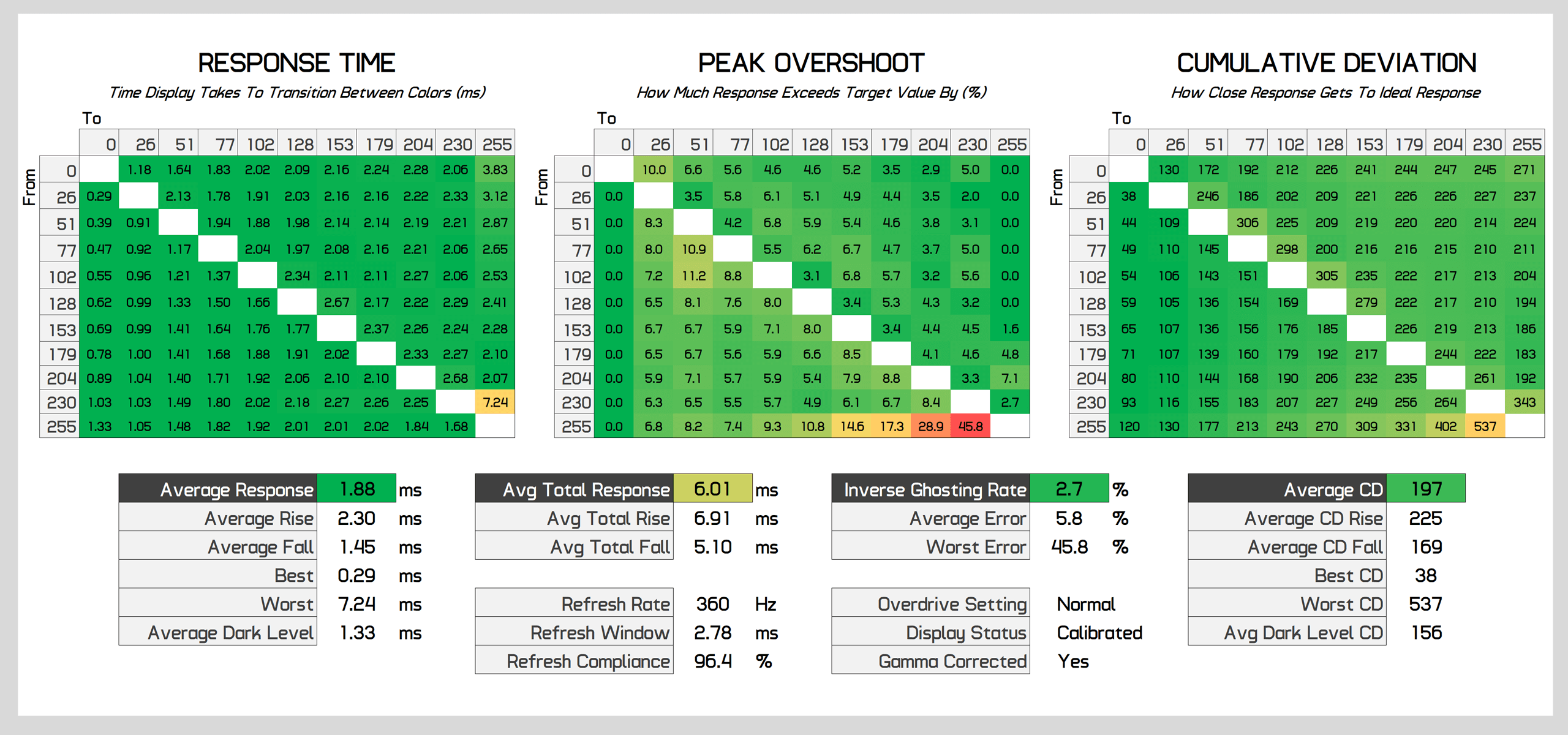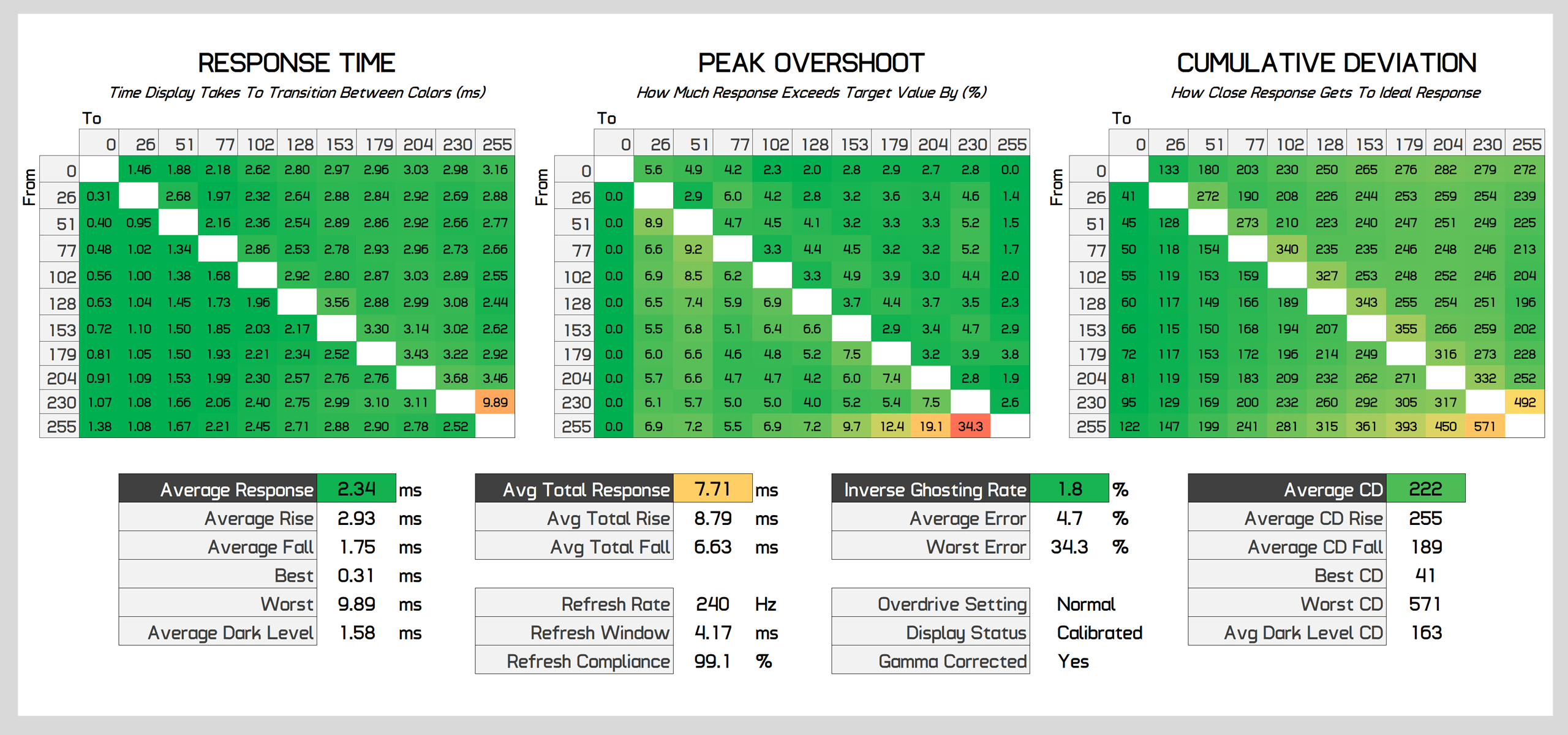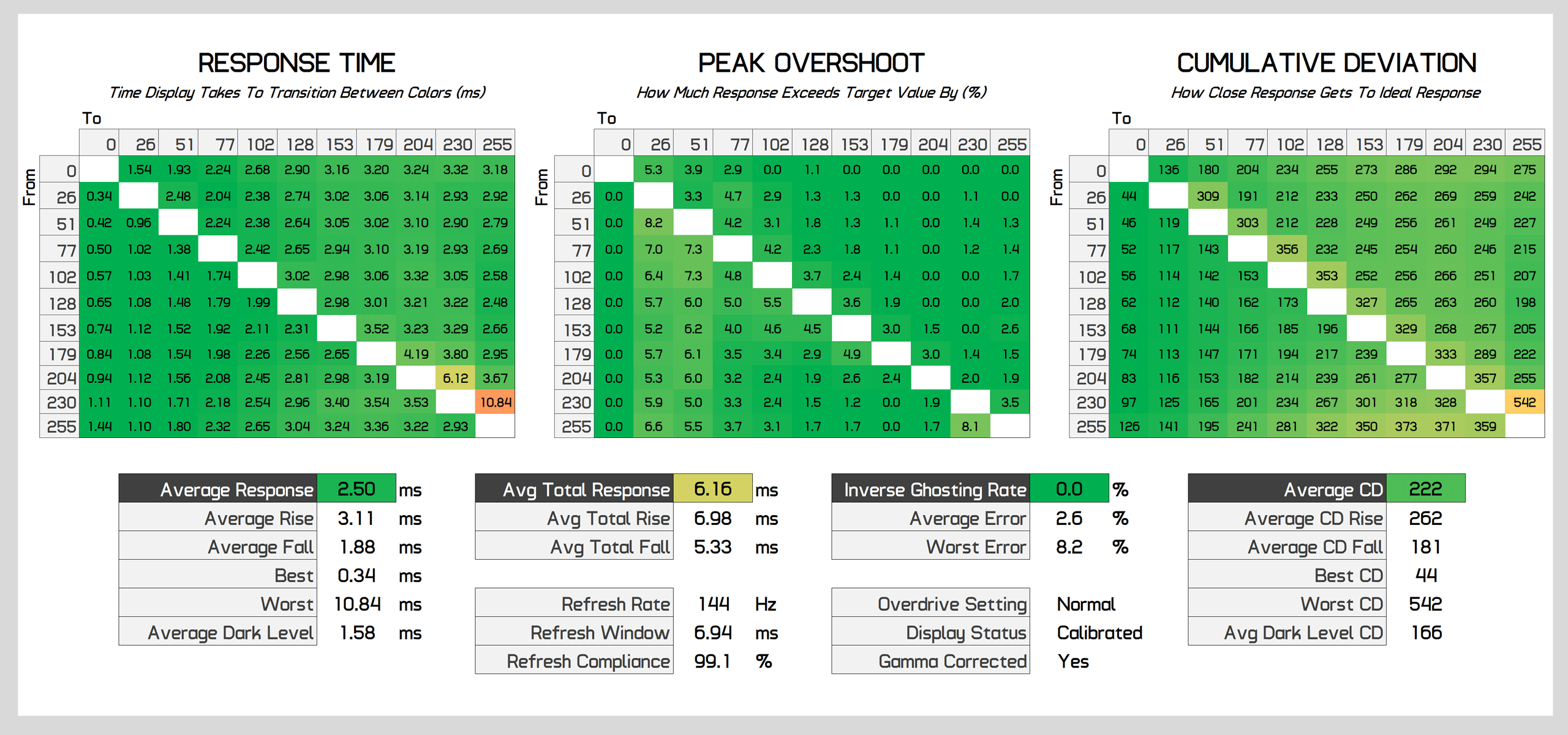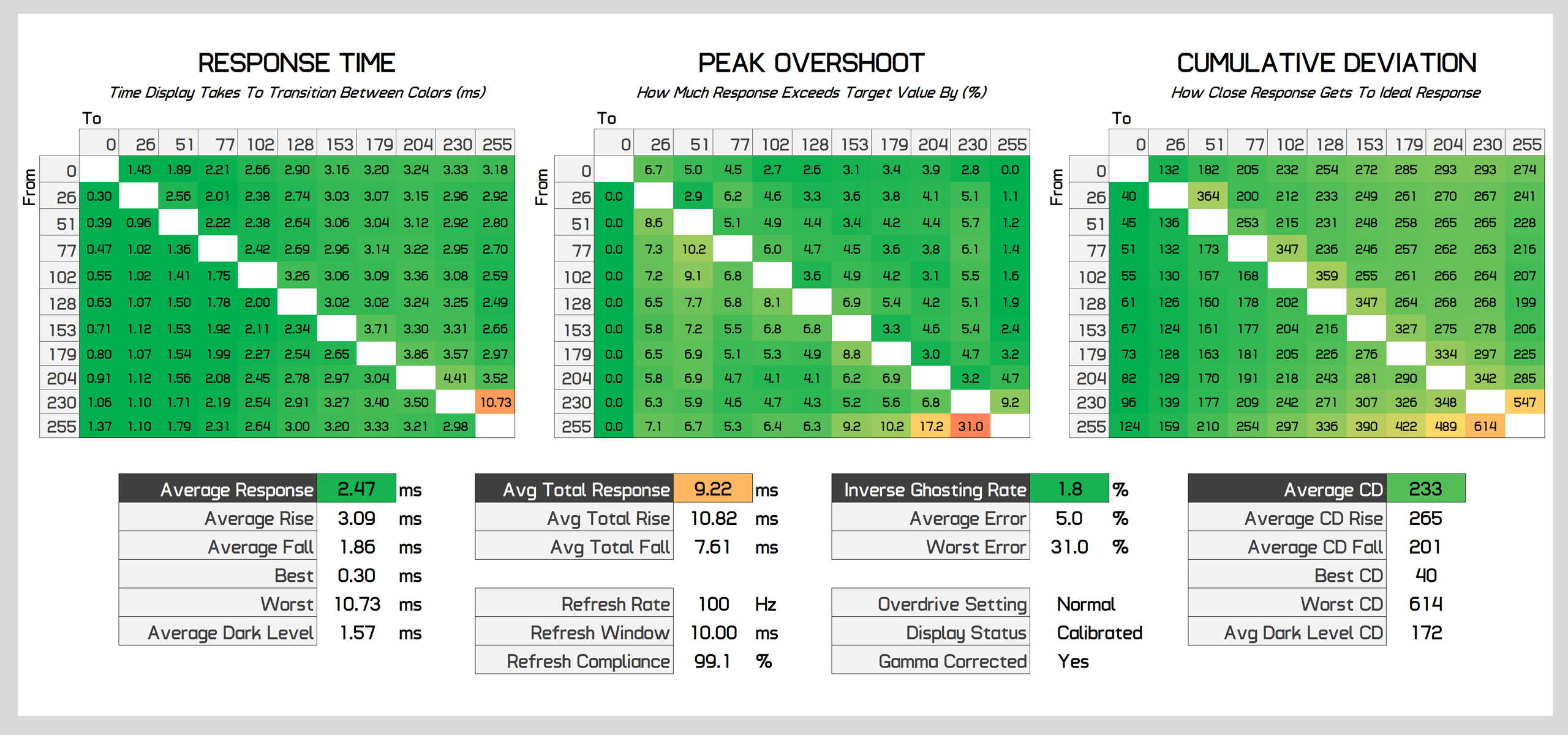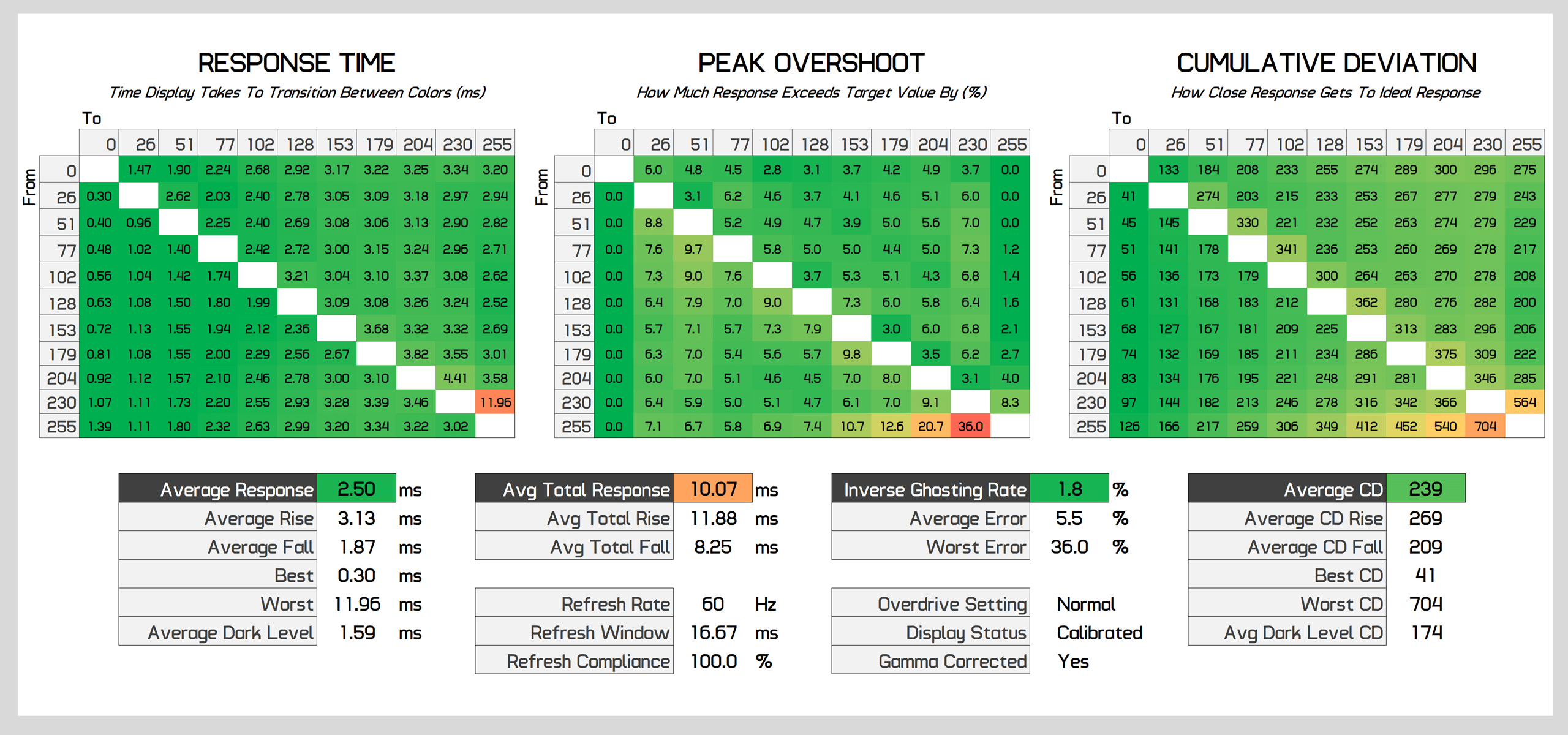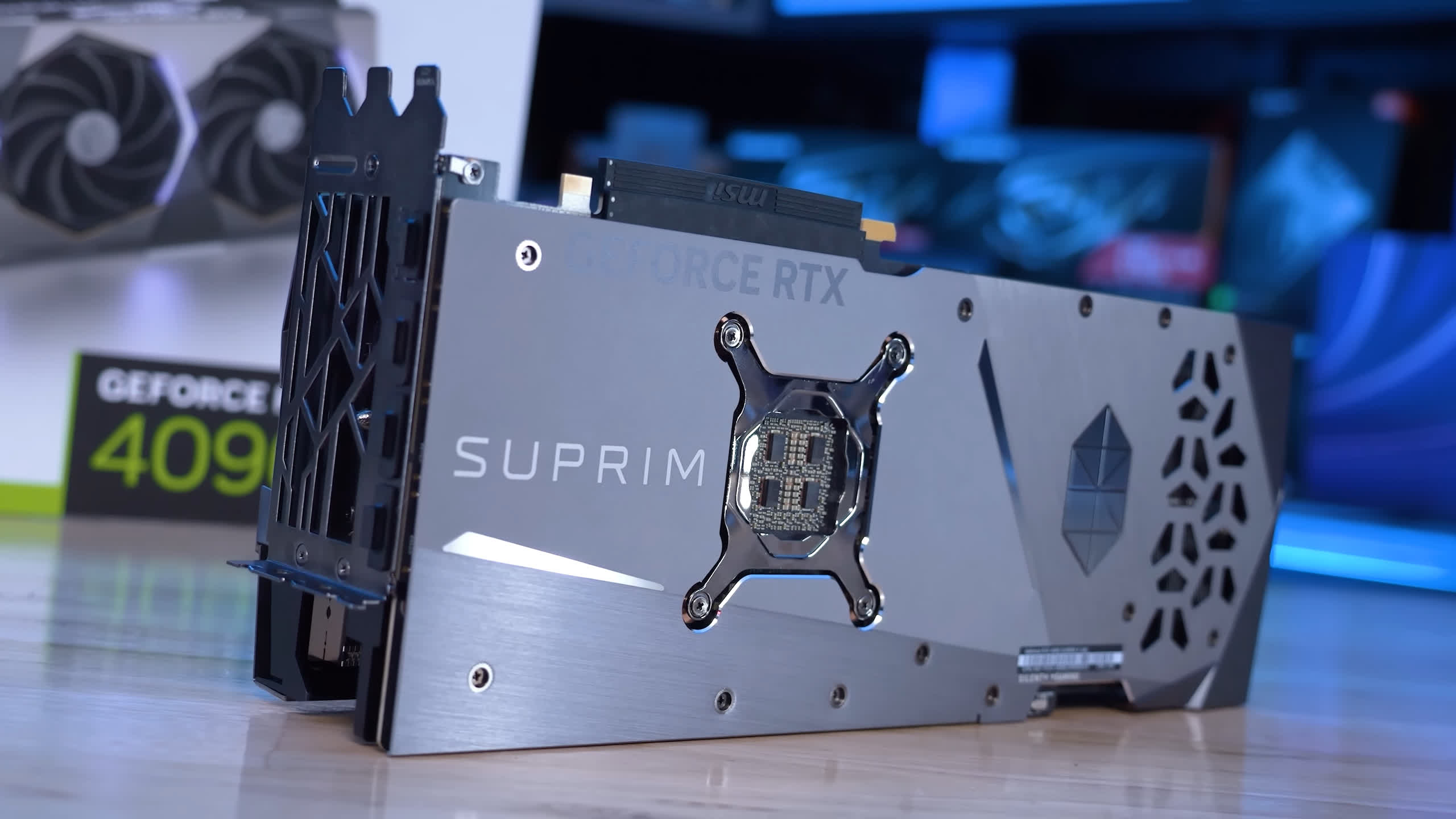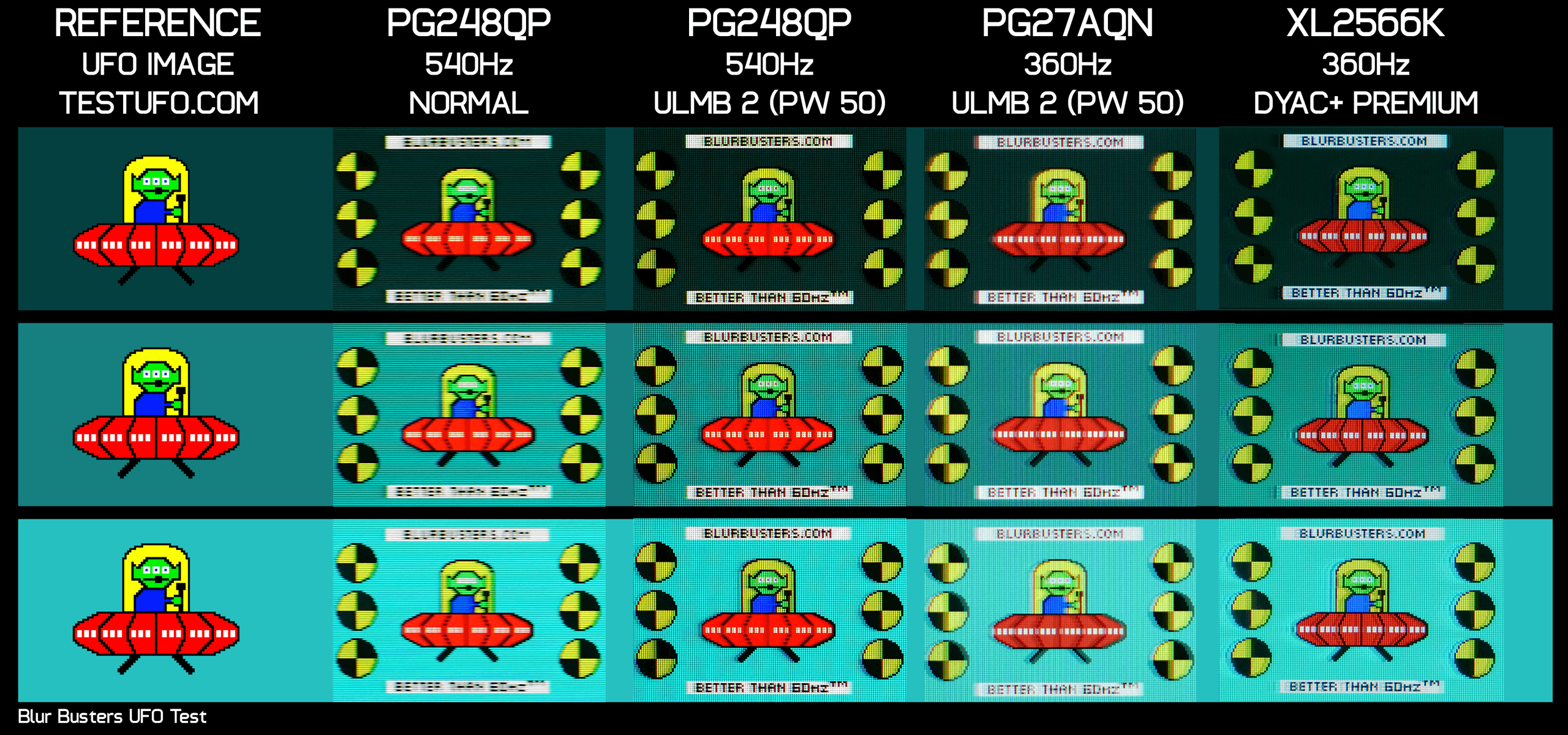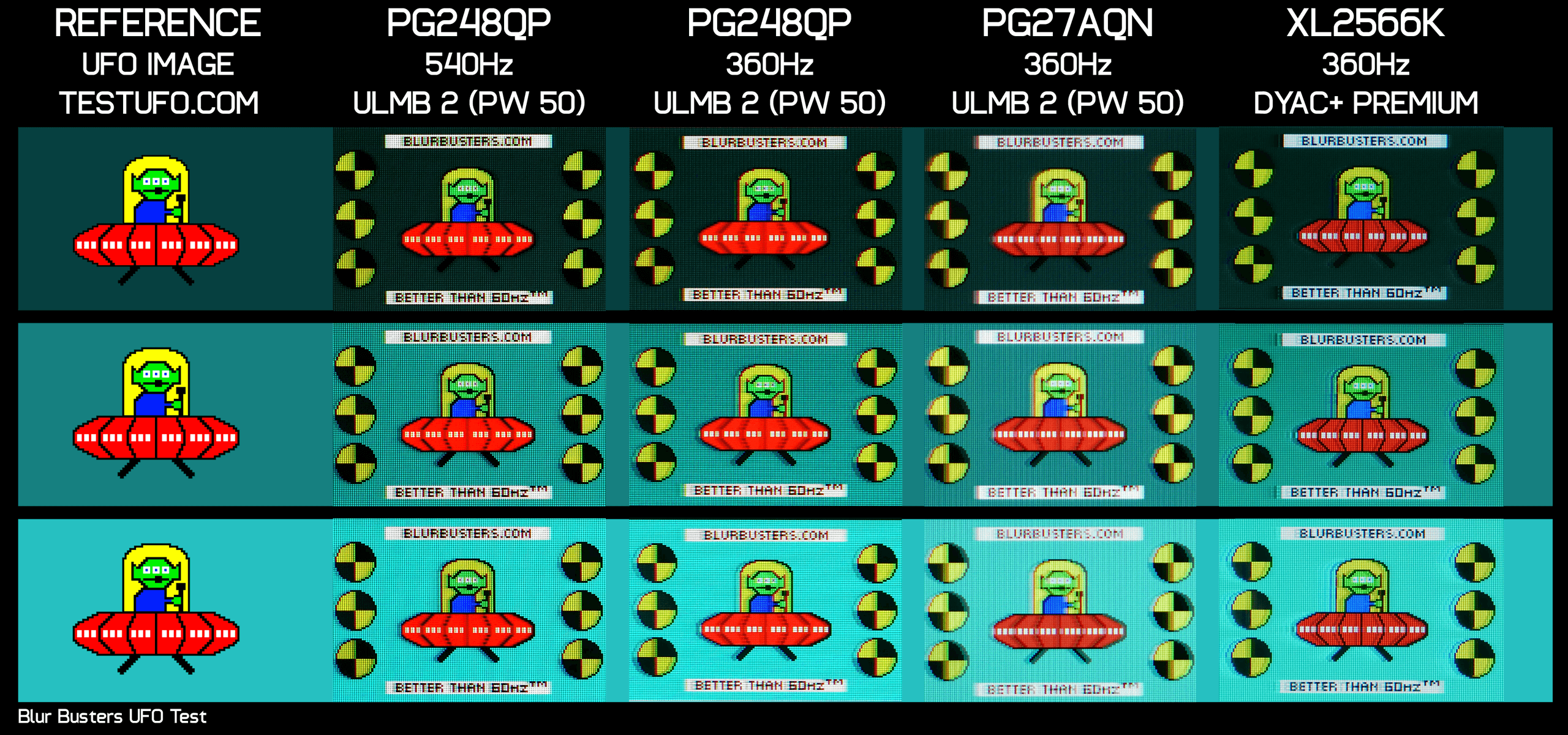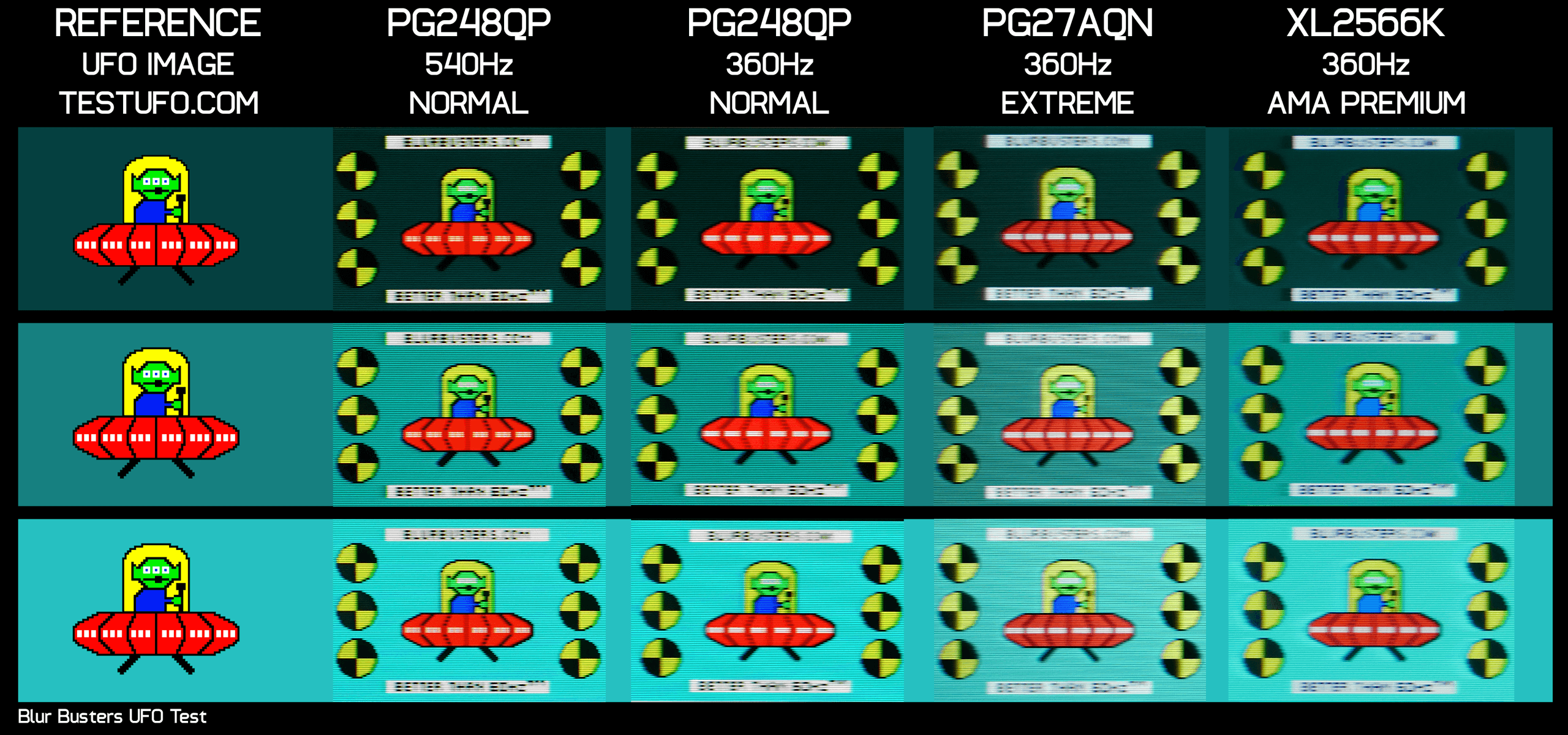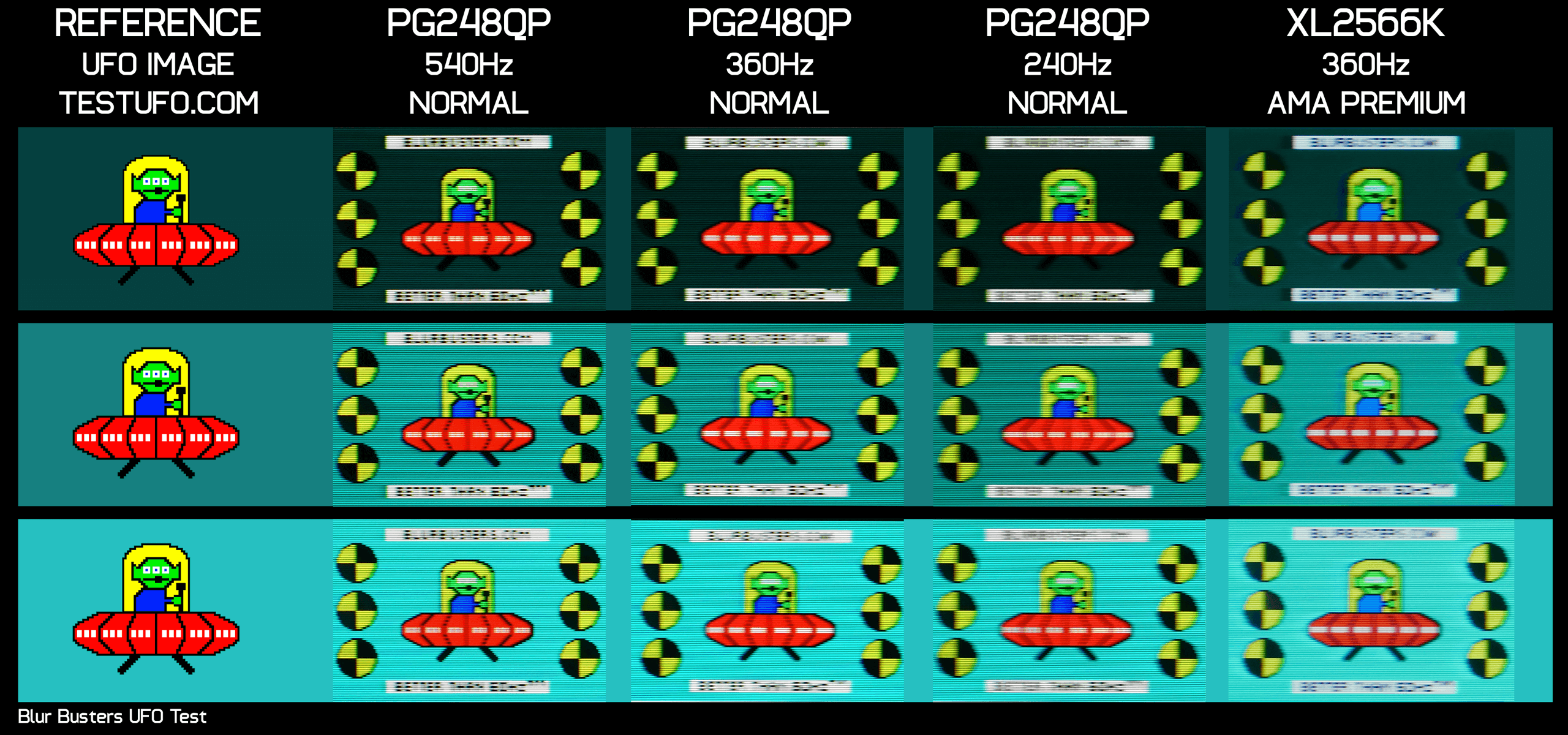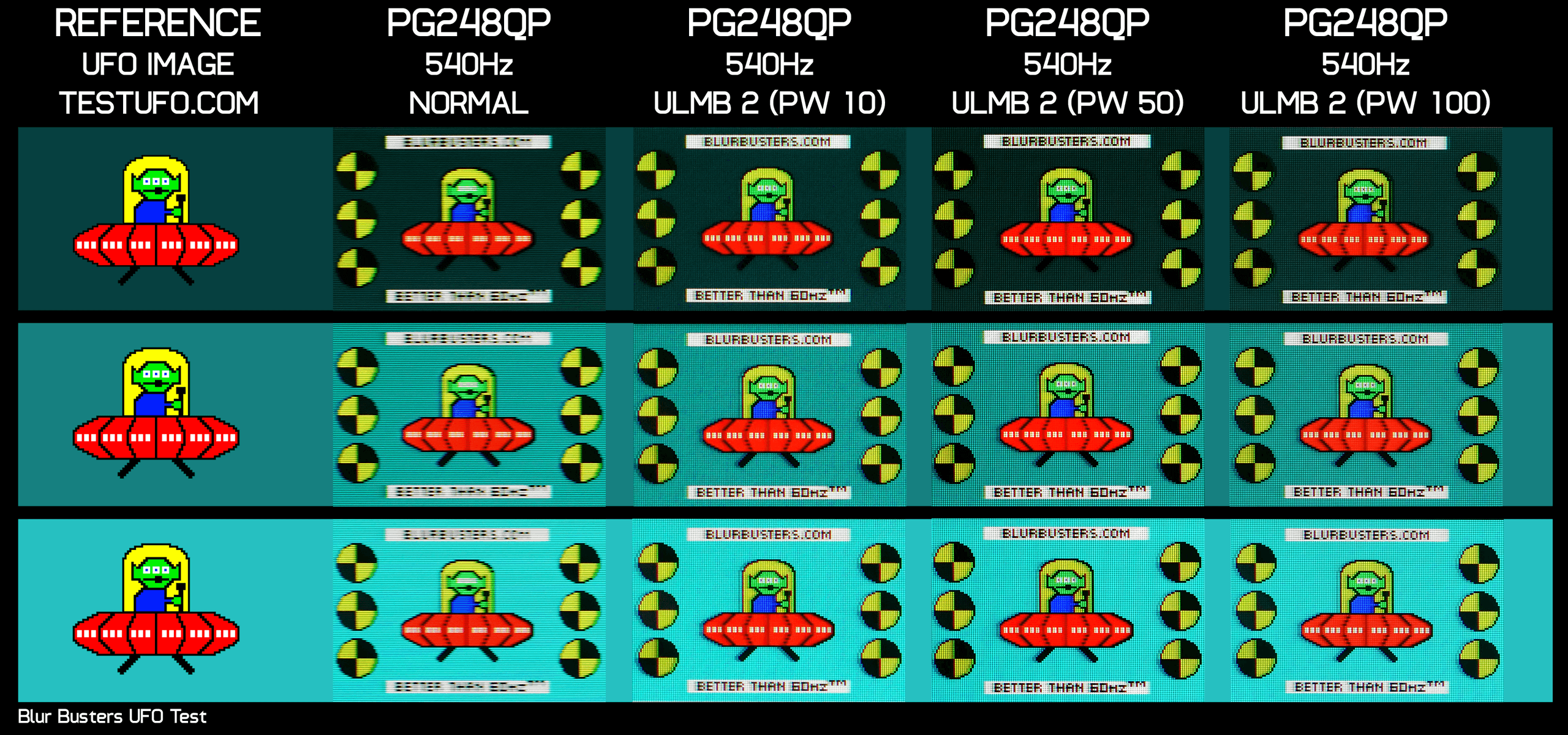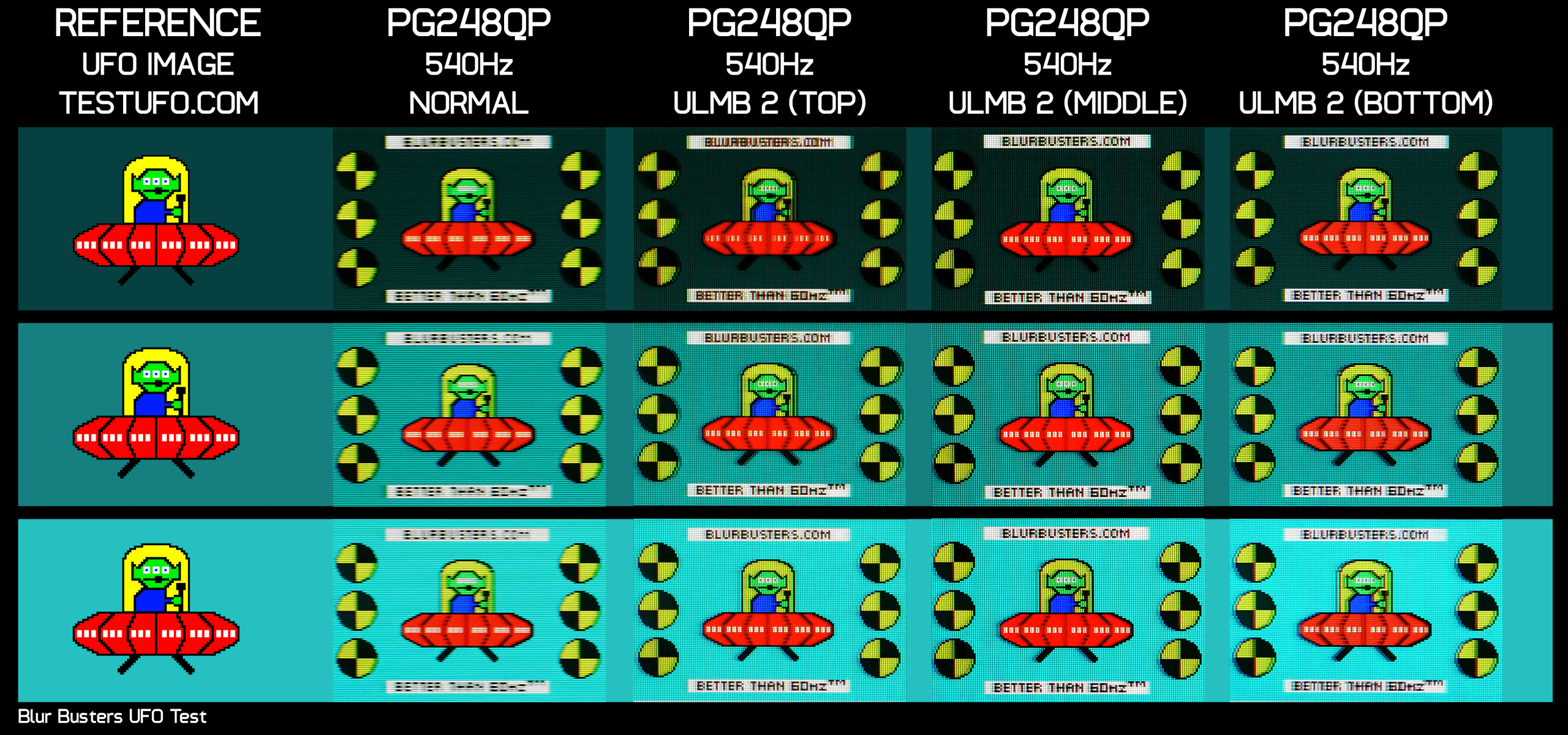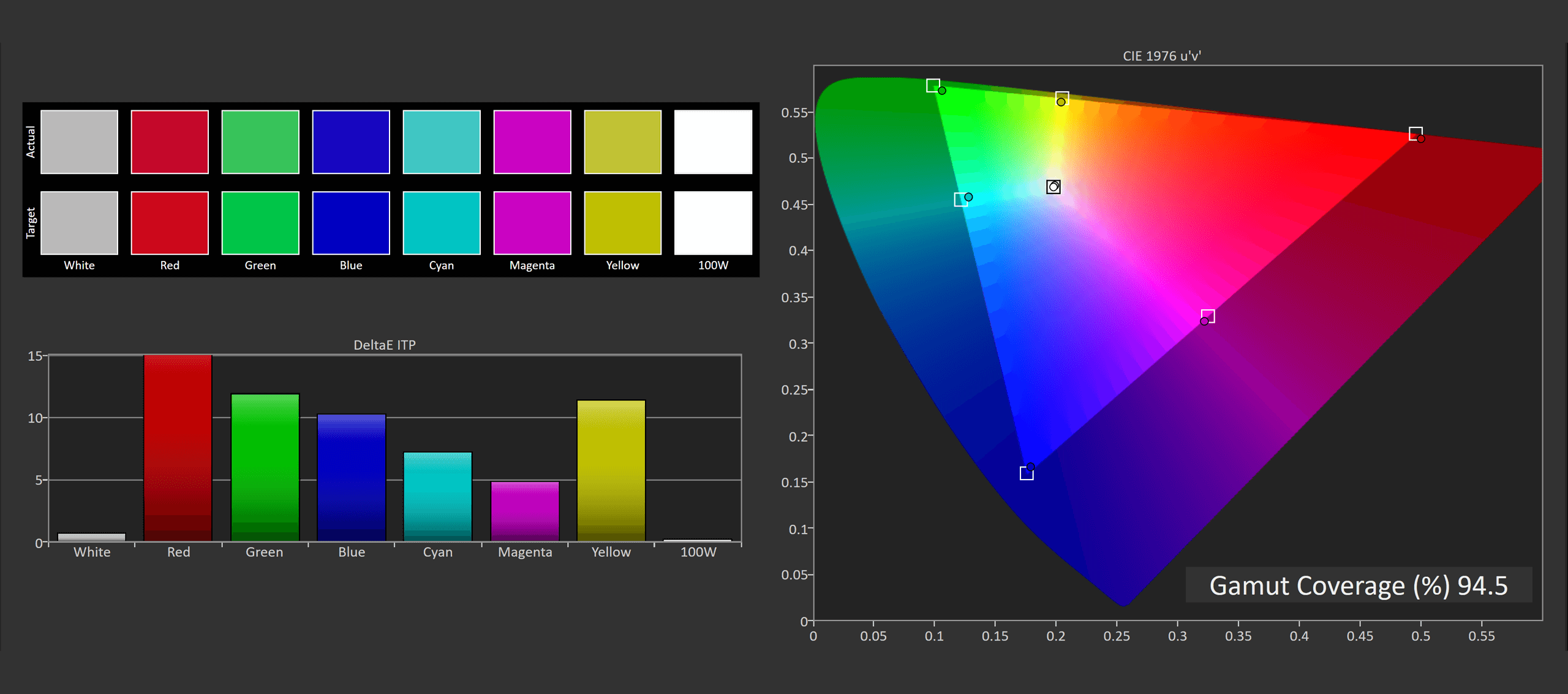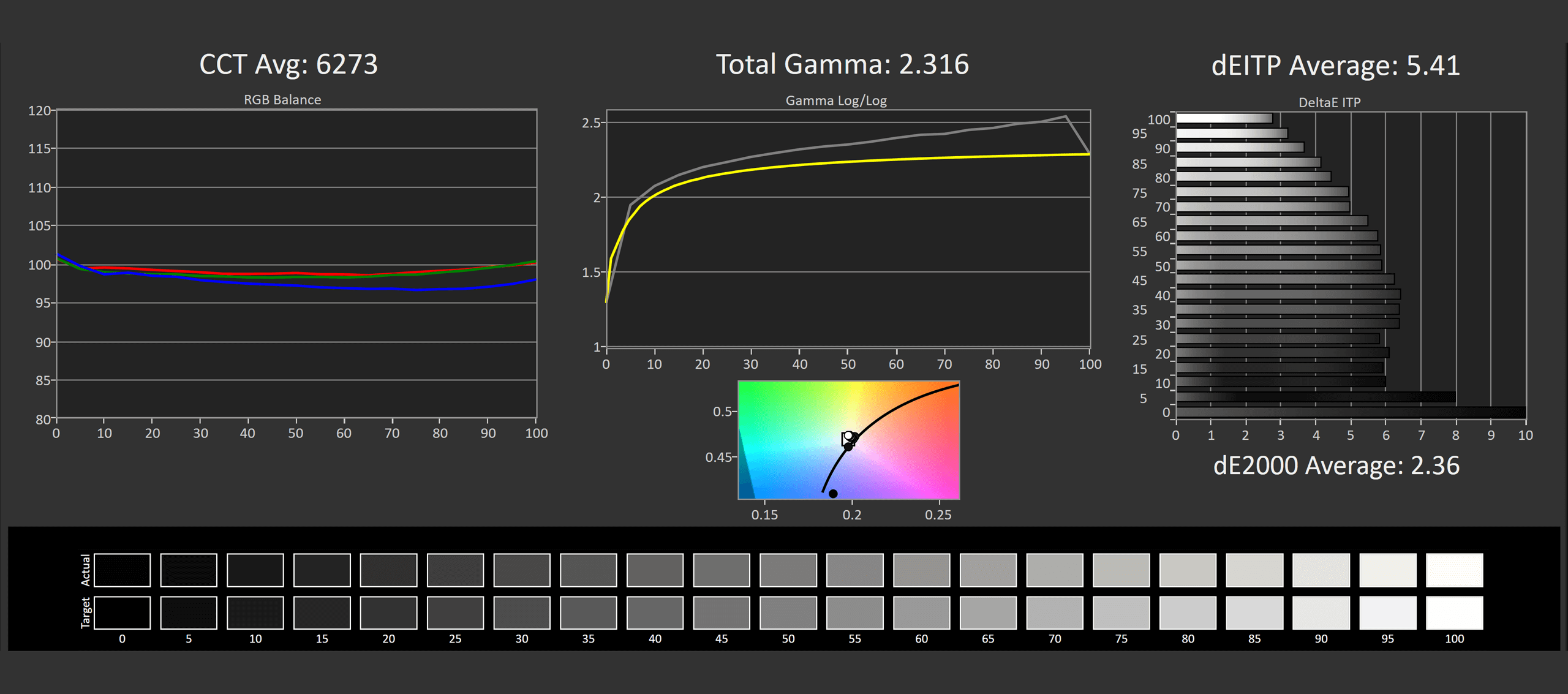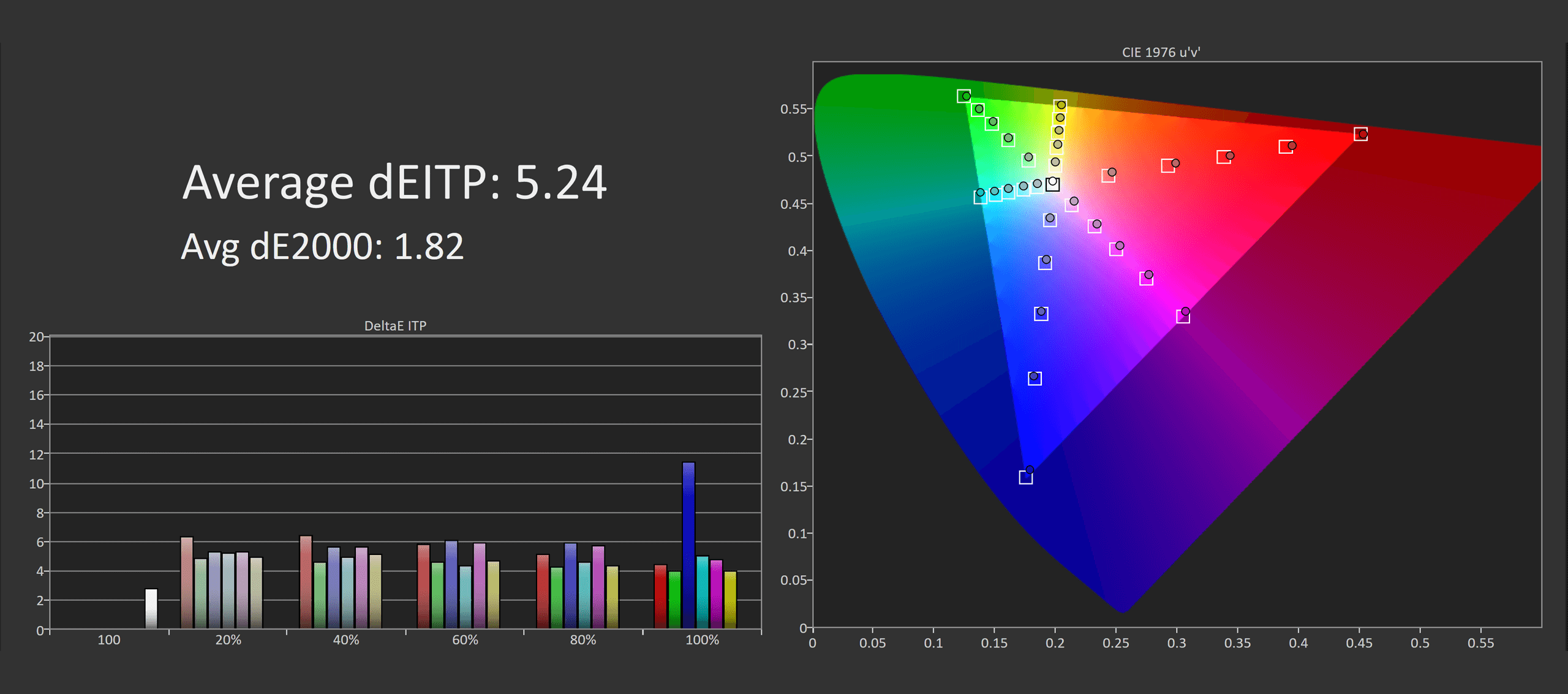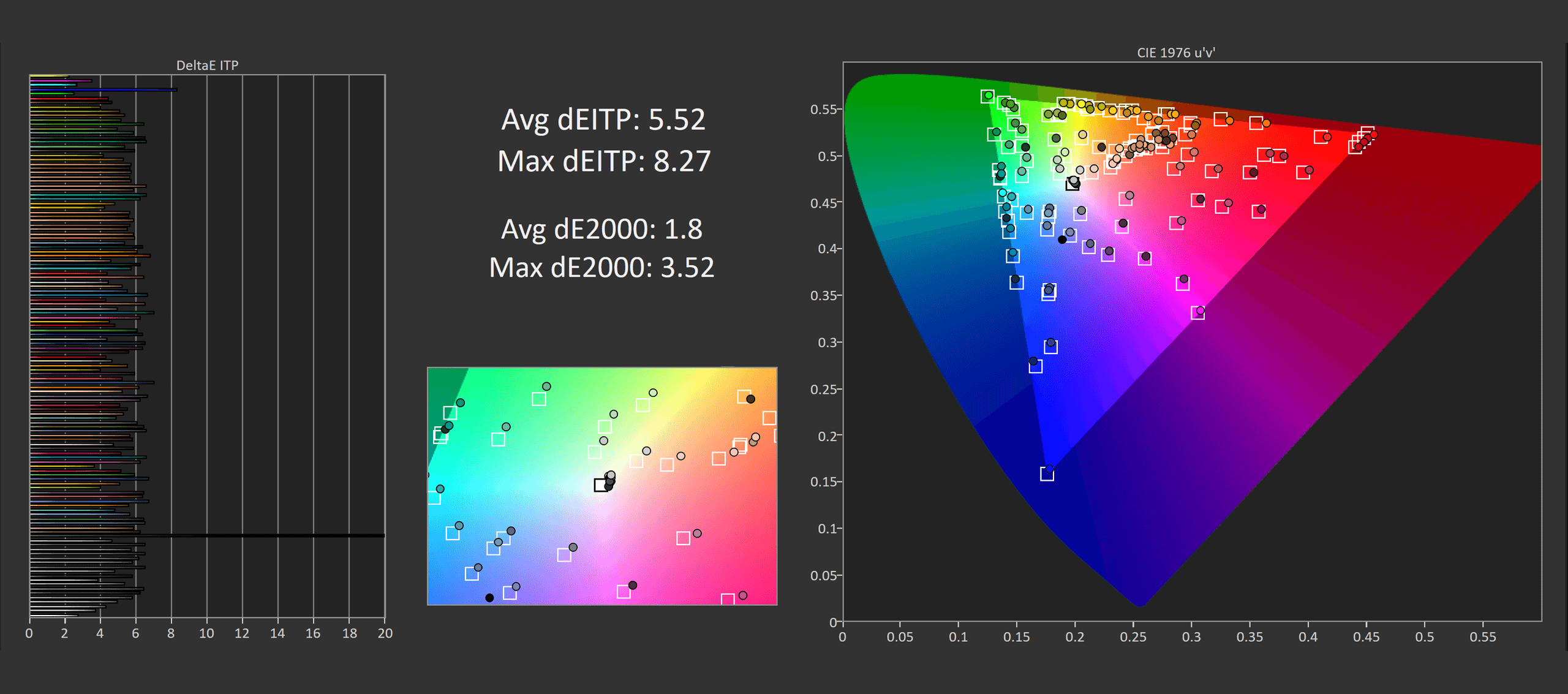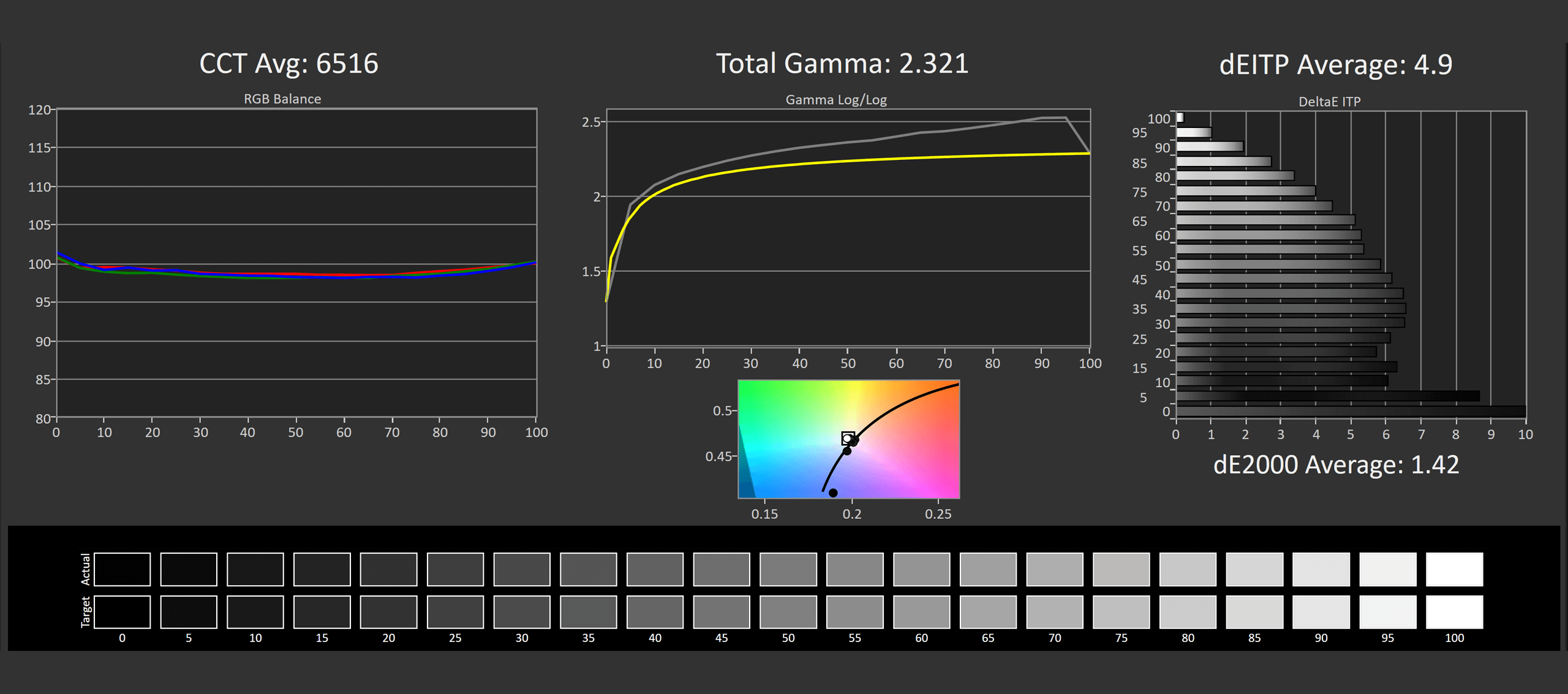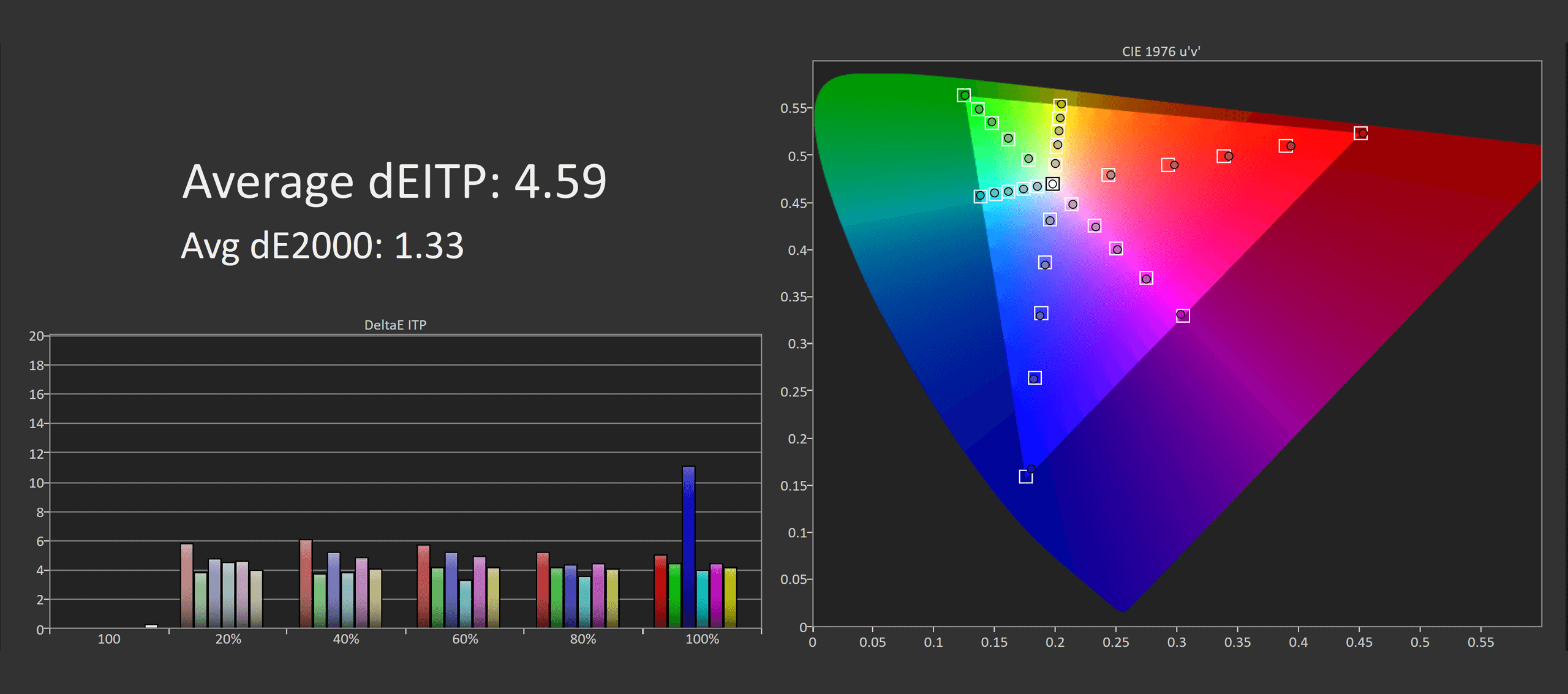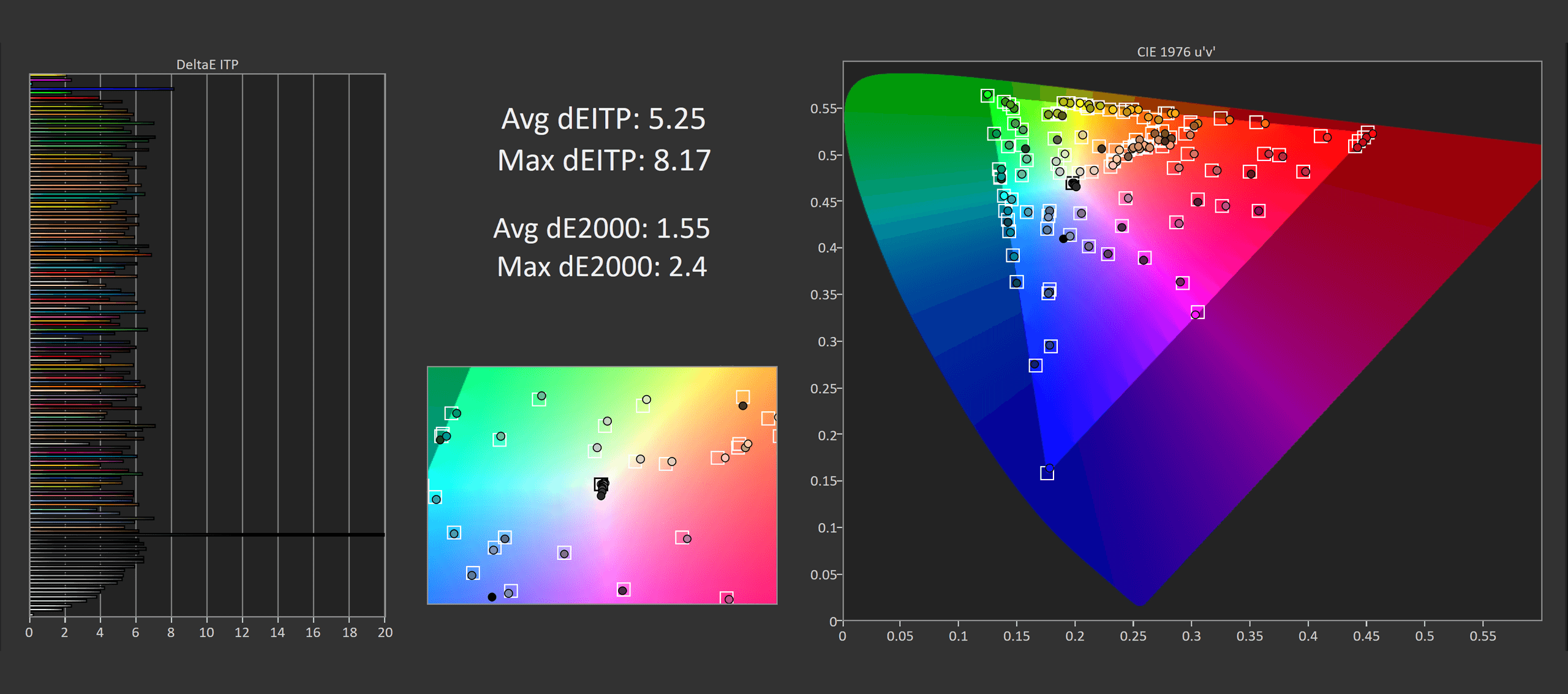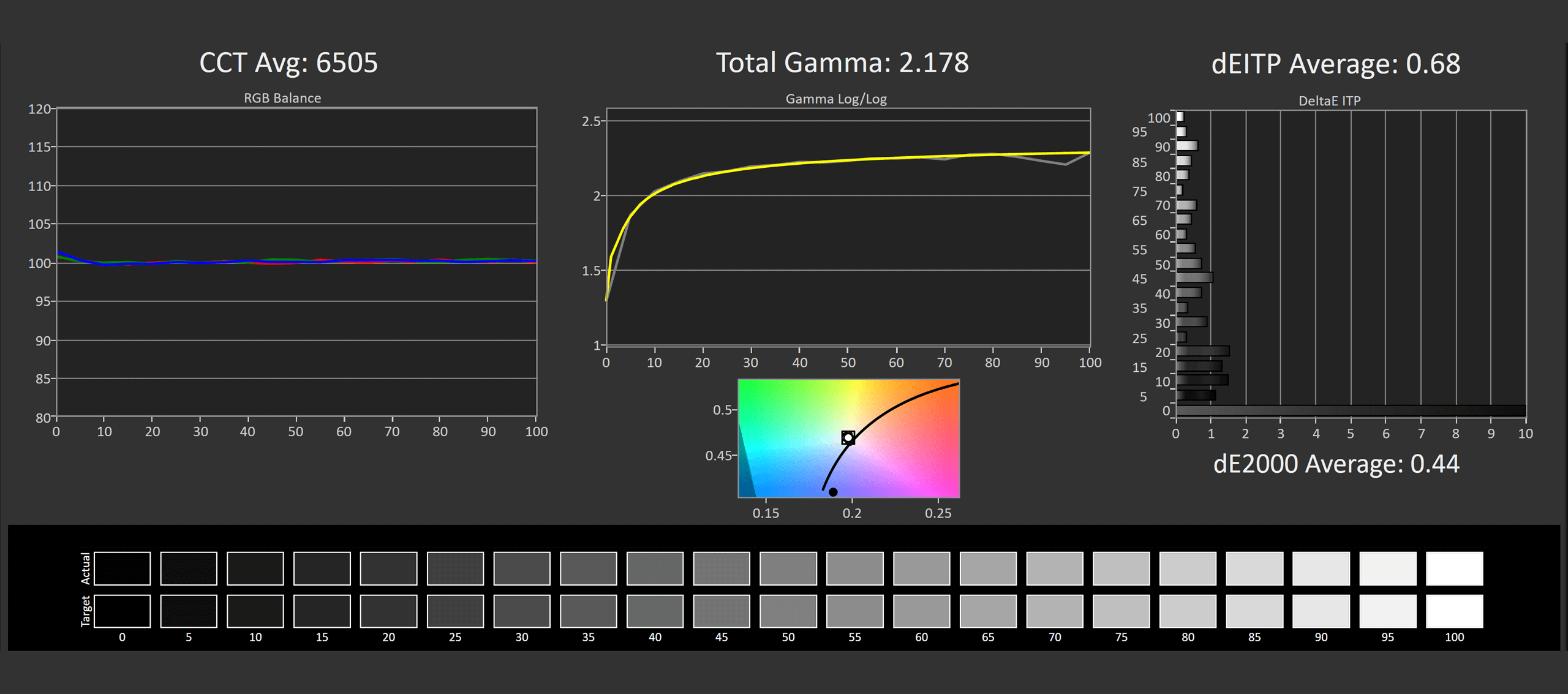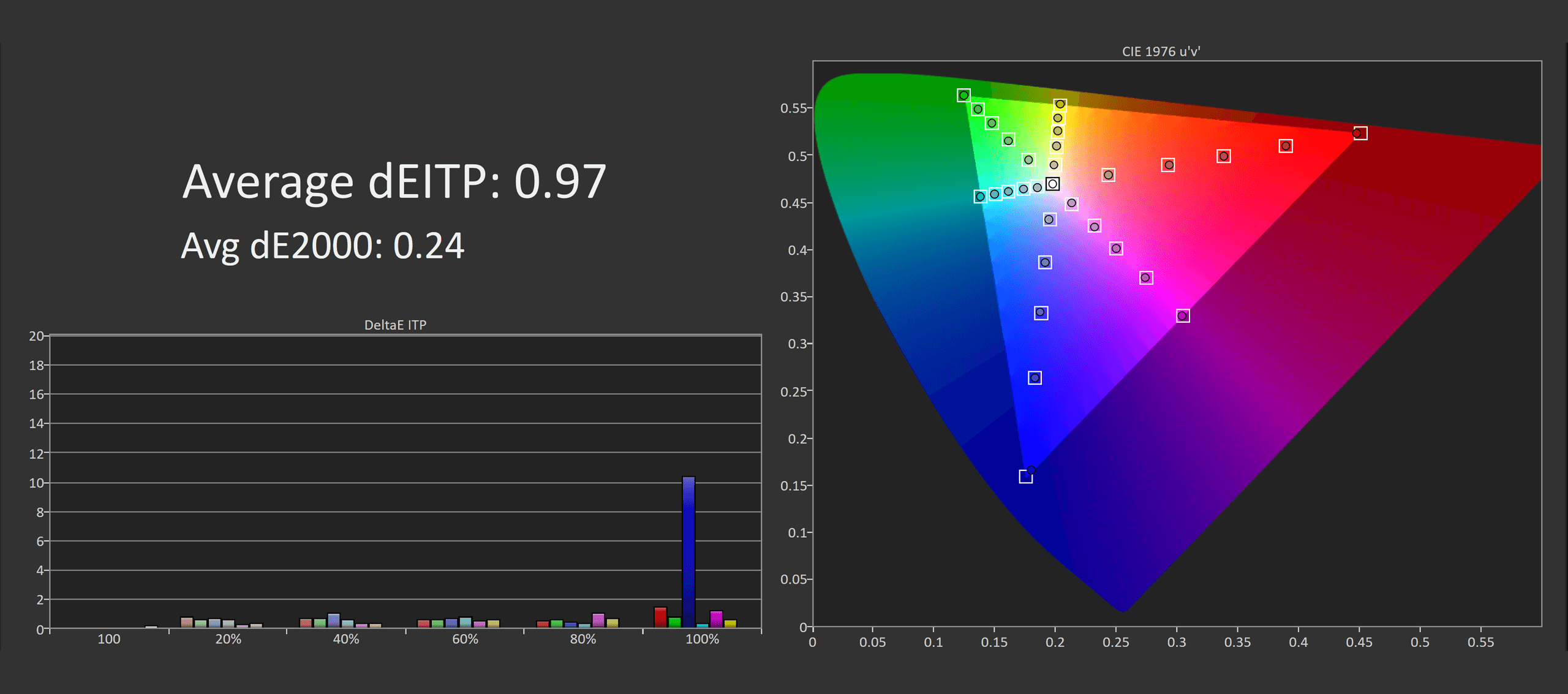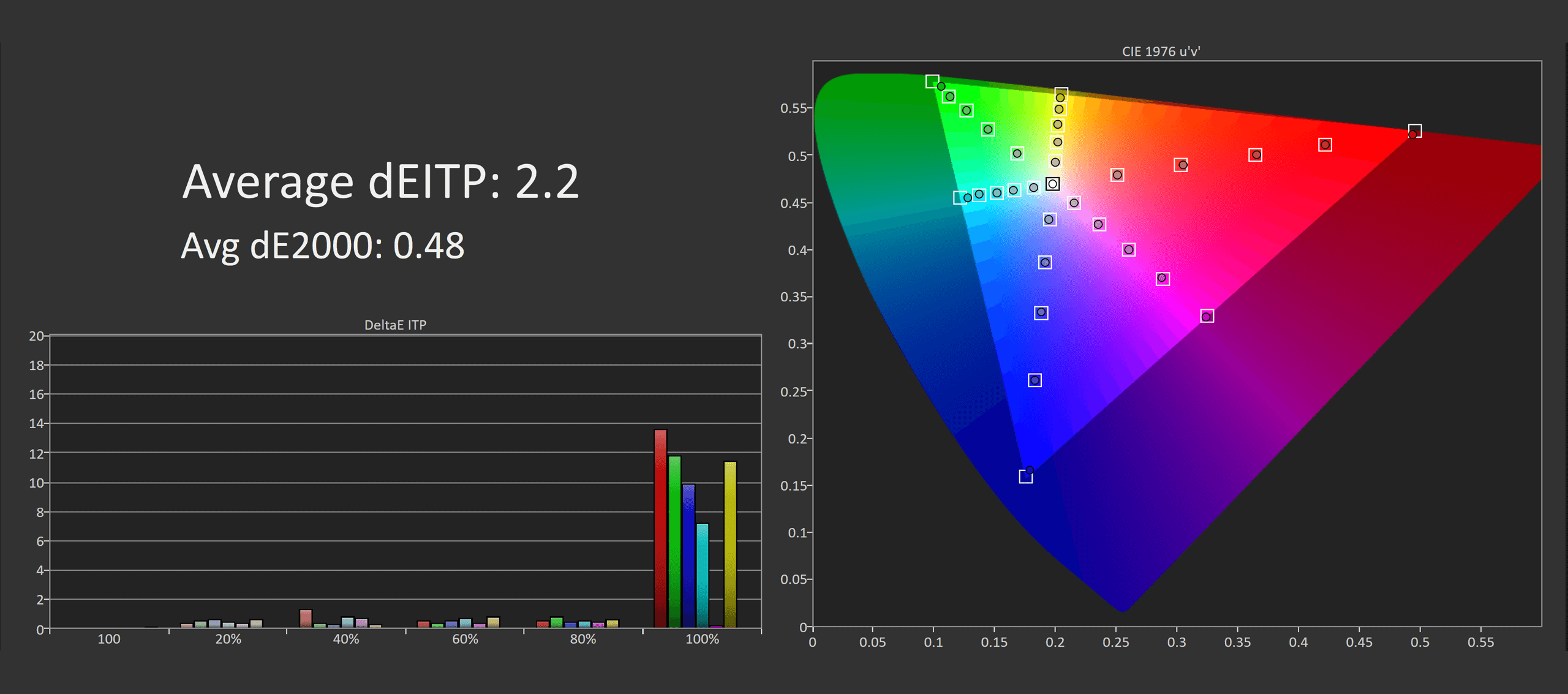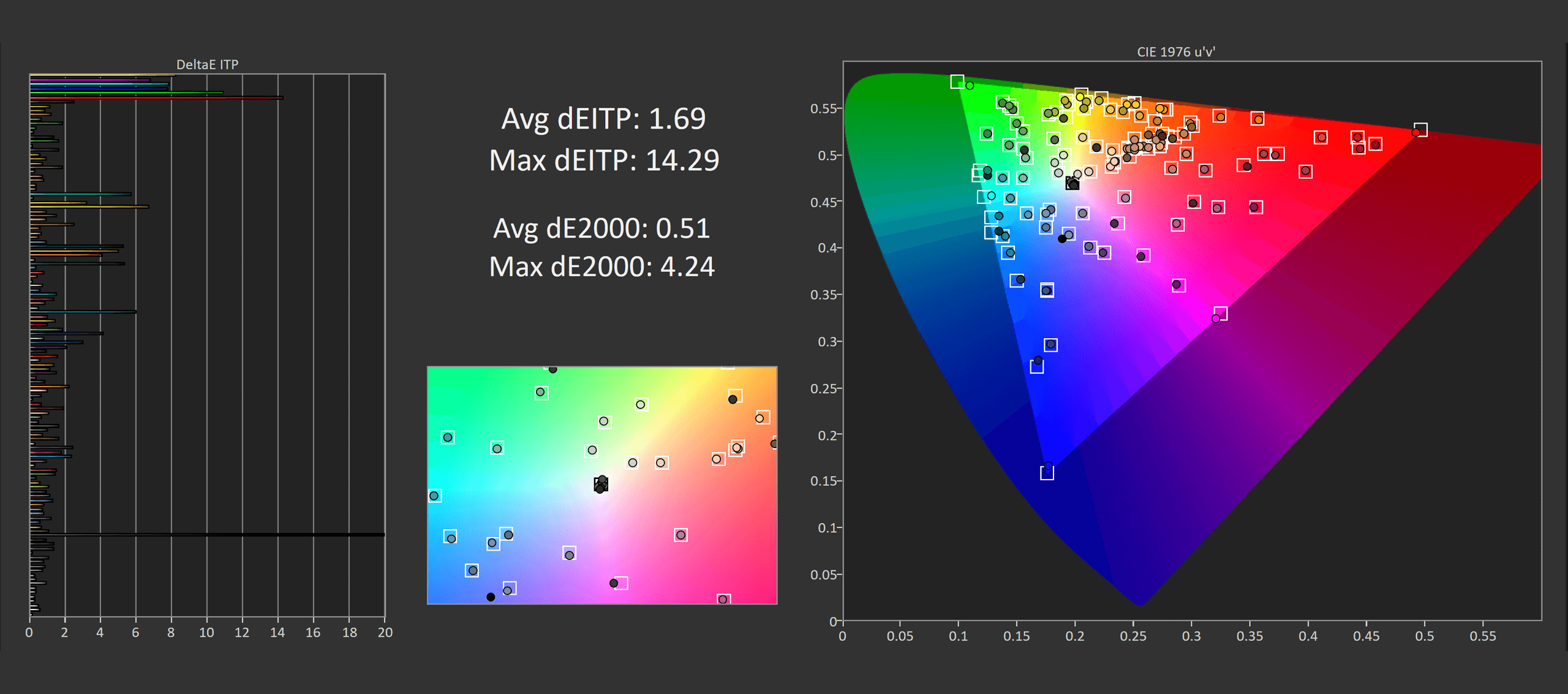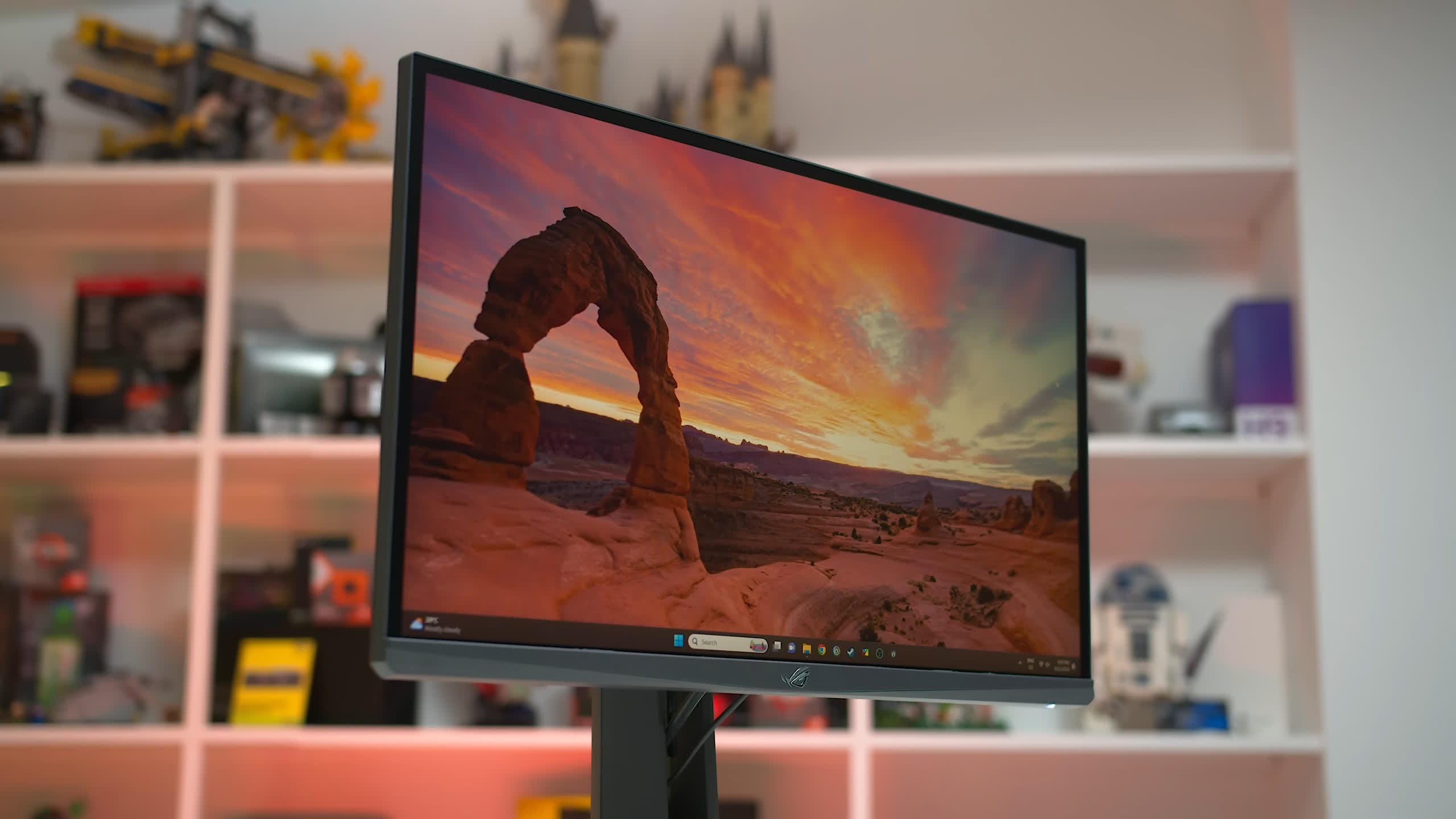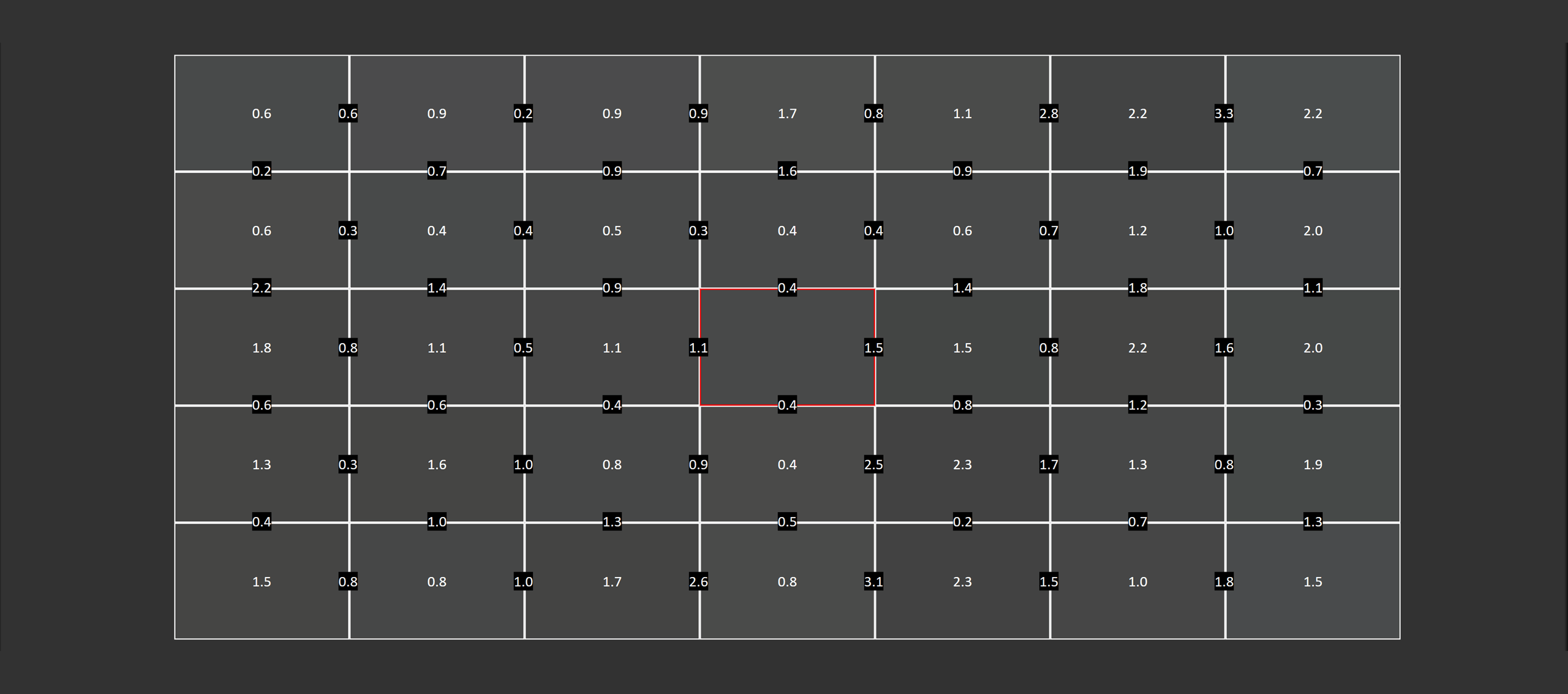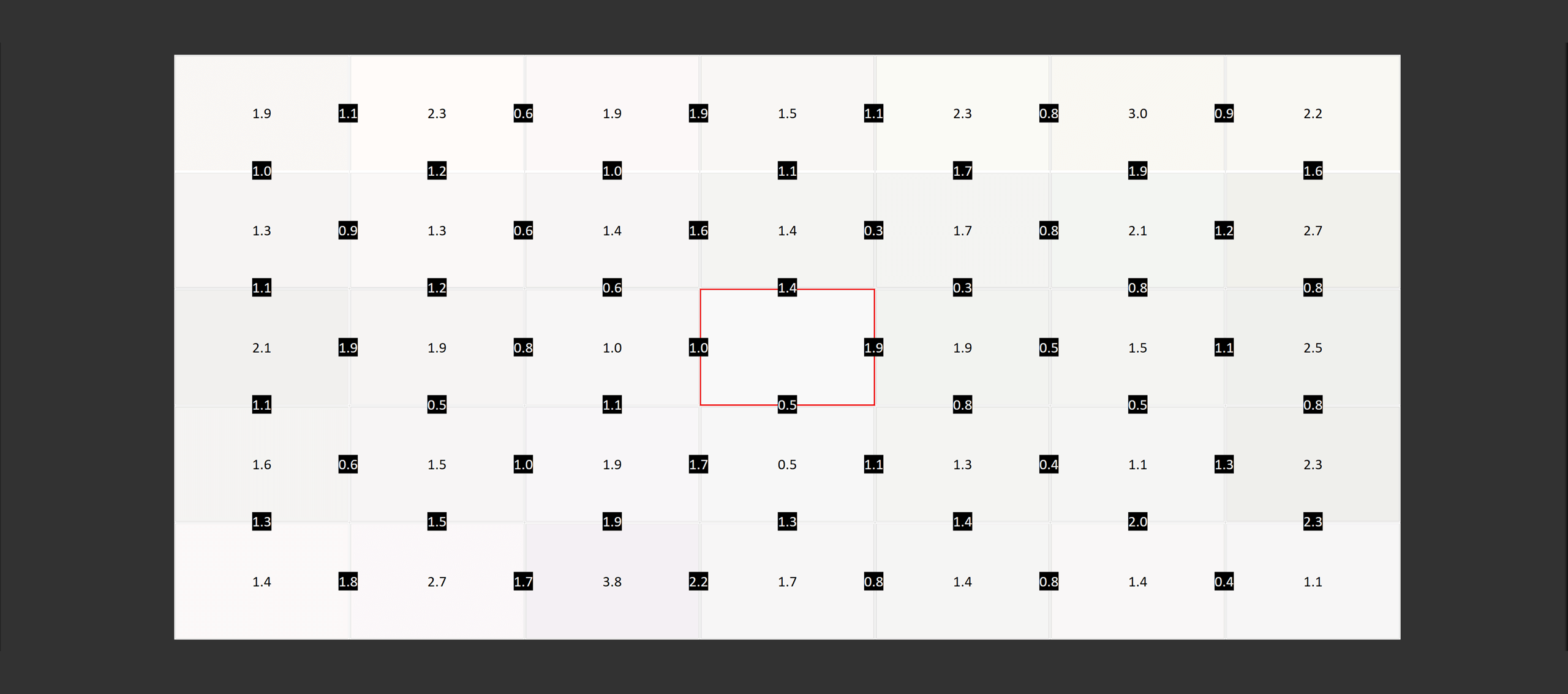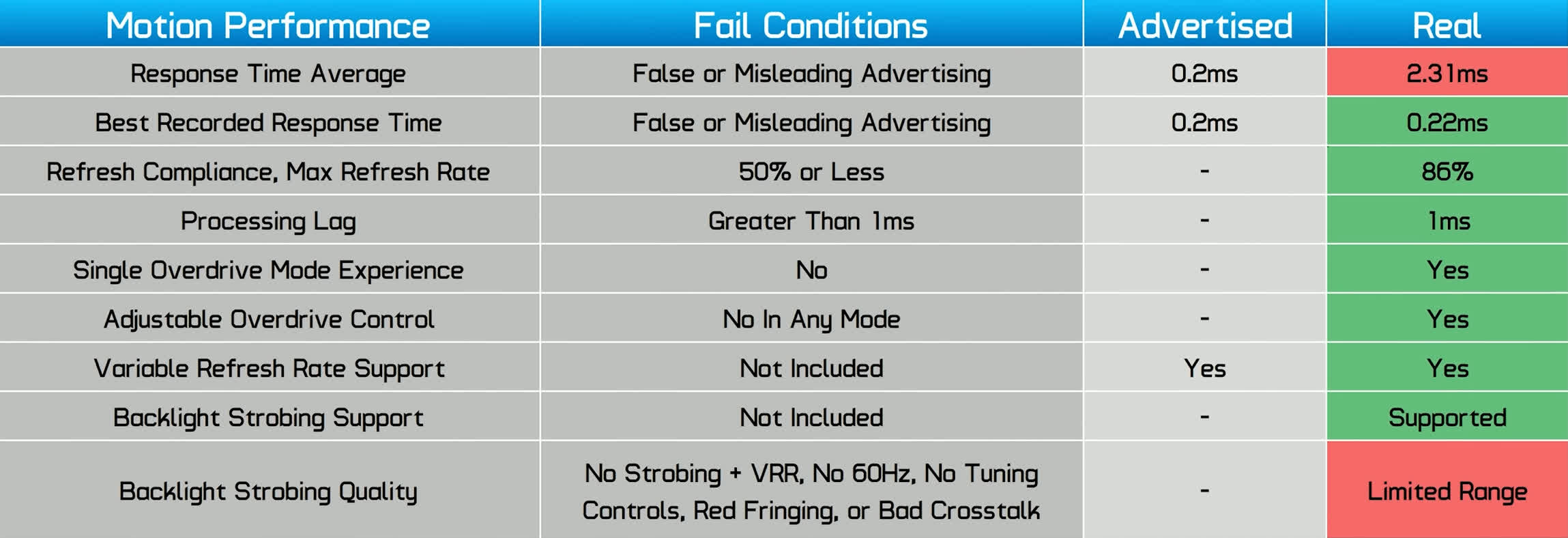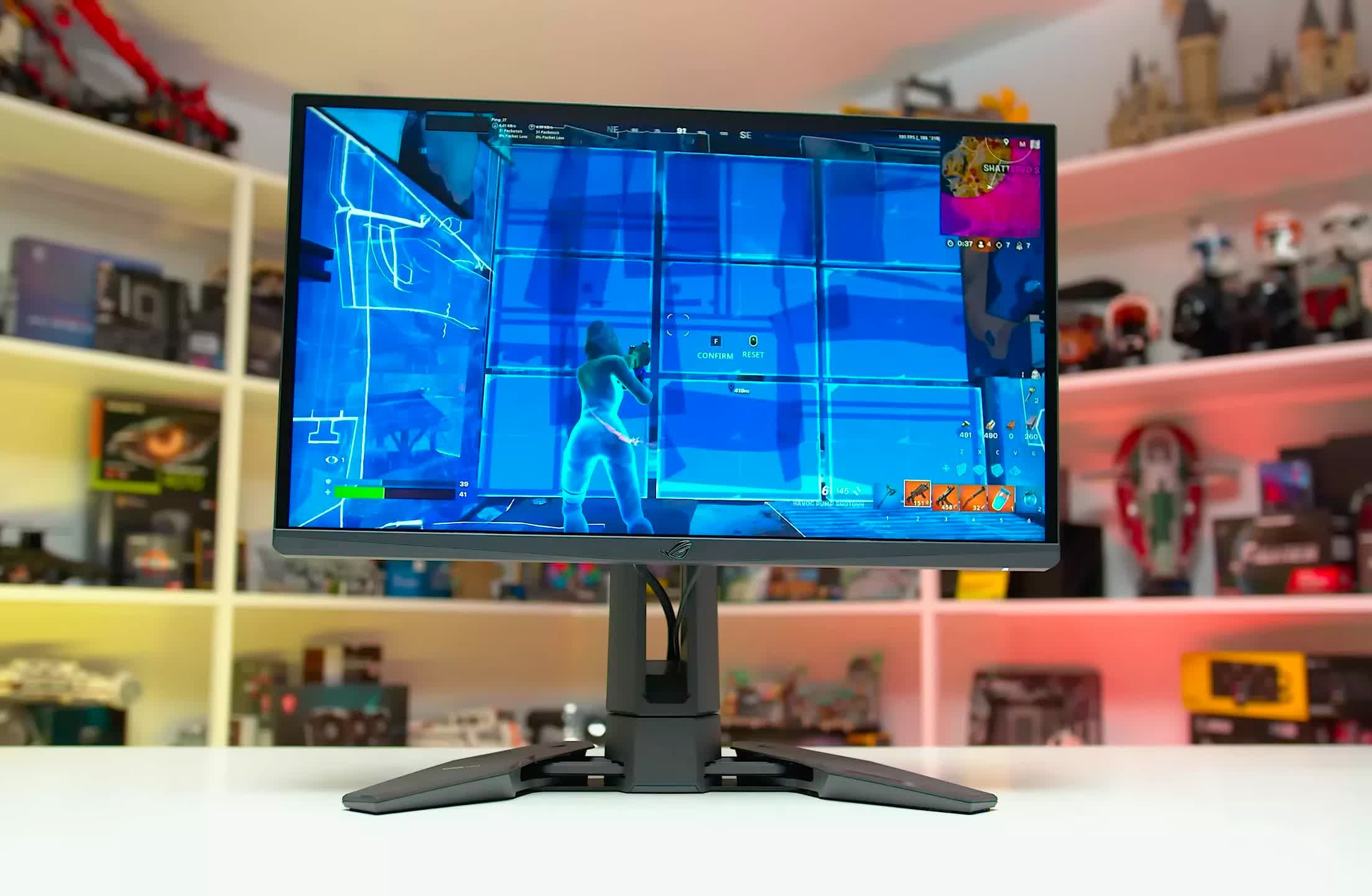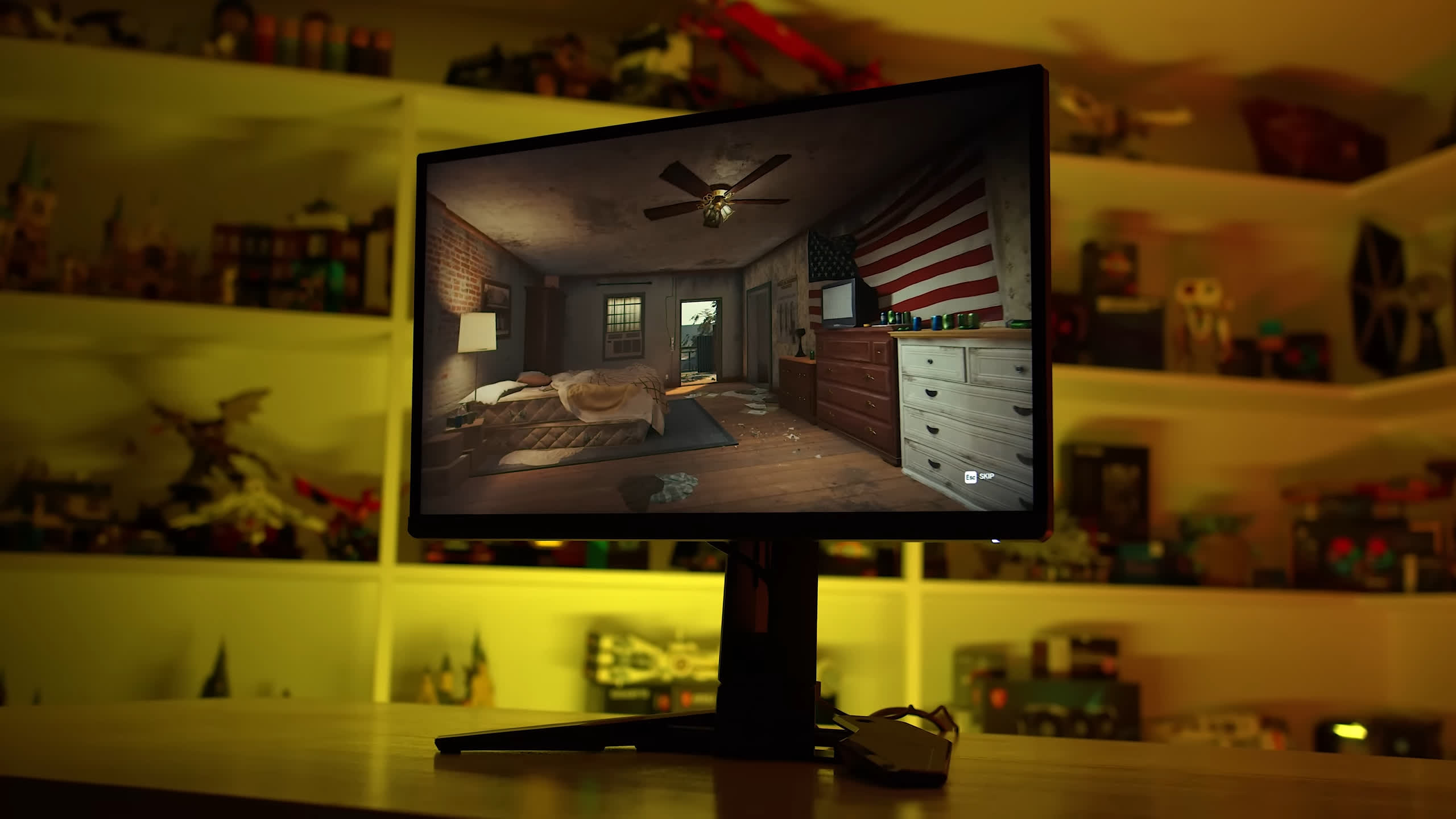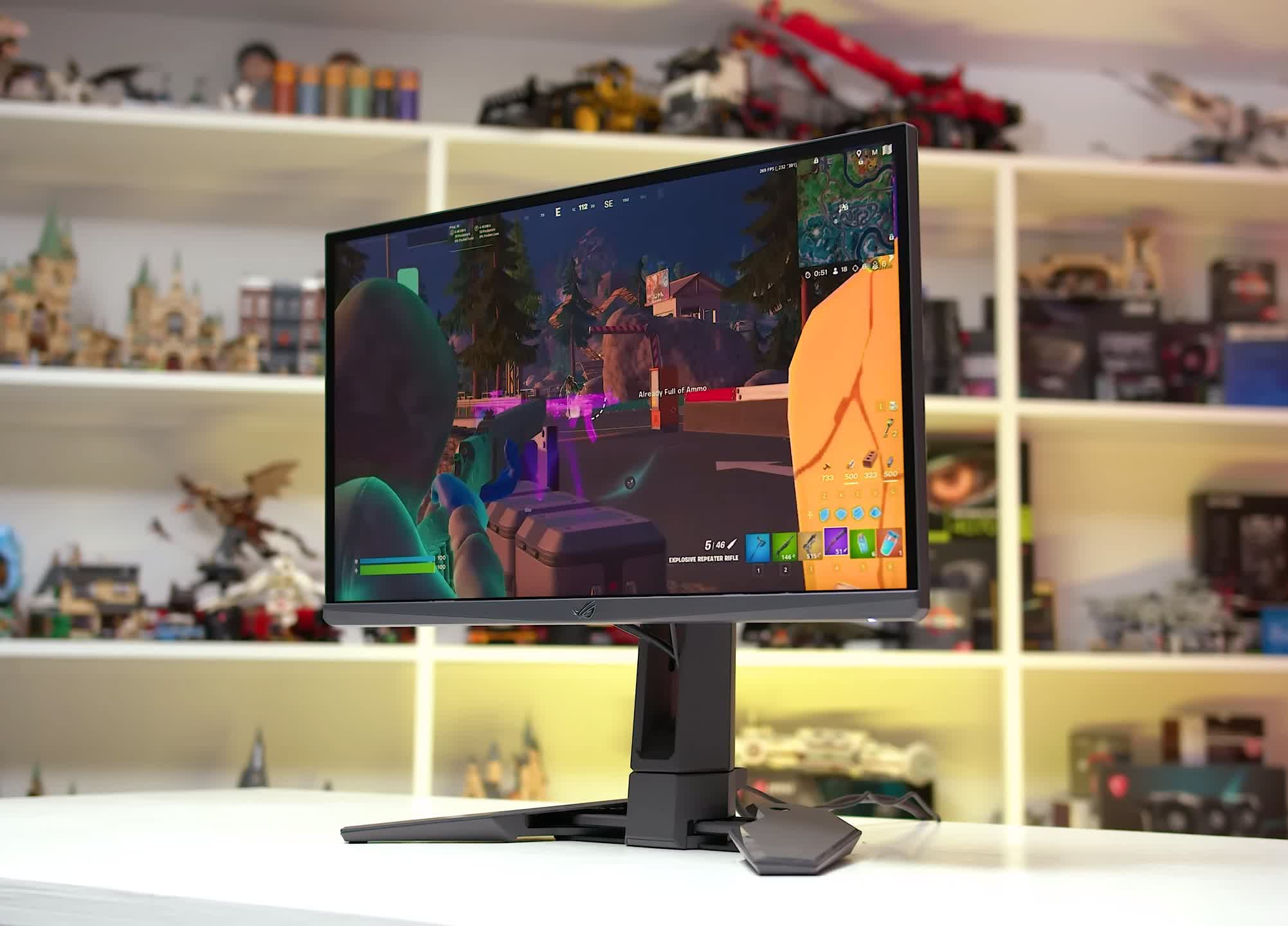The Asus ROG Swift Pro PG248QP is an extremely fast gaming monitor designed for professional esports gamers. It boasts a massive 540Hz refresh rate, serving as an impressive demonstration for the future of high performance, high refresh rate displays, which we hope will become more accessible in the coming years.
Currently, if you want a 500Hz+ monitor, it’s LCD panels with either IPS or TN technology that provide such speeds. Asus has opted for what they describe as an “E-TN” panel for this monitor, or “Esports TN,” claimed to be the world’s fastest TN panel and “approximately 50% more responsive than traditional TN panels.” We already know that TNs are the fastest type of LCDs available, making them a logical choice for a performance-focused display, despite some sacrifices in color quality and viewing angles.
Specs and Design
This display features a 24.1-inch 1920 x 1080 TN panel, with 540Hz achievable through an overclocking feature in the OSD. It includes a G-Sync module from Nvidia, providing adaptive sync support, Ultra Low Motion Blur 2 technology, and the Reflex Latency Analyzer. Asus has also listed DisplayHDR 400 support, though actual HDR hardware support is somewhere between limited and non-existent.
Priced at $900, we don’t expect Asus to sell many of these, except perhaps to a select few multiplayer gamers that want to try it out and have cash to burn. However, the primary goal of this monitor seems to be to demonstrate the feasibility and value of 500Hz+ refresh rates, as well as to provide a bit of a halo effect for other Asus monitors.
Discussing the refresh rate, 540Hz is only supported in the latest builds of Windows 11. Previous versions of Windows capped at 500Hz, so updating to the latest version is necessary for full functionality. This is a minor issue for most gamers, but it’s worth noting for those still on Windows 10 or earlier versions.
We also noticed differences in 540Hz compatibility between Nvidia and AMD GPUs, possibly due to Nvidia’s proprietary G-Sync hardware module. Basically, if you have an Nvidia GPU, nothing to worry about, 540Hz works with full variable refresh rate support up to that maximum. With an AMD GPU, 540Hz also works, but you won’t get variable refresh rate support at that maximum: even if everything appears enabled, the monitor remains capped at 540Hz as indicated by its built-in refresh rate counter. It’s only at 500Hz and below that you will get full VRR support. Not the biggest deal, 540Hz vs 500Hz is just an 8% difference, but something to be aware of.
As for the benefits of the refresh rate itself, we’ll see how it impacts motion clarity a bit later in this review, but even using this monitor for desktop apps it’s a massive step up for responsiveness and smoothness over most typical refresh rates of today.
Going from 144Hz to 540Hz is night and day, I know some people believe that anything above 144Hz is diminishing returns; I disagree, even for something as simple as browsing the web and navigating through Windows, 540Hz is significantly smoother and any action you take or input from your mouse feels near-instantaneous in a way that becomes crystal clear when returning back to the much slower world of 144Hz.
We also think it’s a noticeable upgrade over 240Hz, the refresh rate here is more than doubled, which leads to a corresponding improvement to latency. Less of a gain than from 144Hz surely, but when comparing 540Hz to 240Hz we think the weaknesses in 240Hz becomes more apparent than when that refresh rate first debuted. The only real way to describe it is that 240Hz feels slower to use than 540Hz – though it’s probably not enough of a benefit to justify the astronomical price increase to access 540Hz.
The Asus PG248QP uses a similar design to previous ROG monitors of this size. Most of its outer surfaces are made of simple grey plastic, which, while well-constructed, doesn’t quite match the expected build quality for a $900 1080p monitor. The rear panel features a gamery design with an RGB LED illuminated ROG logo, a common sight in many recent monitors.
A unique and interesting aspect to this design is the new base which is adjustable between a wider setup and a more closed setup. The thinking here is that esports gamers often like to use pretty unconventional keyboard and mouse positions, so having this level of adjustability caters to many different types of gamers. It’s a smooth and straightforward transition between the two positions, and you can set any position between the two maximums as well.
The base design doesn’t compromise on the stability of the monitor though, it’s a rock solid build that also includes full ergonomic adjustability for the display itself: all of height, tilt, swivel and pivot is included here. However, the use of the G-Sync hardware module does translate into active cooling with a slow spinning fan that’s audible at close range.
You might be able to hear it in a dead quiet room, but I found it very difficult to hear over my PC’s quiet fans during normal operation. The fan didn’t ramp up and down aggressively during my time testing it, which is good. It’s those changes in speed and volume that are the most noticeable and most annoying; this fan is just a constant low speed that’s near inaudible.
Connectivity is somewhat limited due to the G-Sync module, packing one DisplayPort 1.4 with DSC and two HDMI 2.0 ports, as well as a two-port USB hub. The DisplayPort is fine, but the use of HDMI 2.0 on an expensive 540Hz display is not good enough, as it limits those ports to just 240Hz, less than half of the maximum. I suspect most people will be hooking up over DisplayPort but still, it’s really about time the G-Sync module is updated to support HDMI 2.1 so that all ports are full refresh rate ports.
The OSD, controlled through a directional toggle, includes a comprehensive feature set, with gaming-specific options like crosshairs and timers. The inclusion of crosshair support in a monitor targeting professional gamers raises questions about fair play – is that considered cheating? If you’re a pro gamer, let us know in the comments – the Reflex Analyzer, useful for Nvidia GPU users, assesses total system latency without needing external hardware and produces more accurate results than PC-side latency tools.
Response Time Performance
The Asus PG248QP includes four overdrive settings, the first of which is off, look at the chart below – quite a good result for no overdrive – this would beat most other monitors with overdrive enabled. But for 540Hz gaming I think most people will want to use the Normal mode at a minimum.
Asus ROG Swift Pro PG248QP – Off – 540Hz
Asus ROG Swift Pro PG248QP – Normal – 540Hz
This is what the Normal mode looks like, it’s incredibly fast. With just a 1.8ms average response time and next to no overshoot, the PG248QP is highly suited to playing at 540Hz with refresh compliance at 86%. Often the concern with these super high refresh rate monitors is that the transition speed isn’t fast enough to keep up with the refresh rate but that absolutely isn’t the case here, even with our relatively strict measurement criteria. This leads to very low cumulative deviation for an LCD.
Asus ROG Swift Pro PG248QP – Esports – 540Hz
Asus ROG Swift Pro PG248QP – Extreme – 540Hz
There are two other modes available, one is Esports which slightly improves the average response to 1.6ms but also slightly increases overshoot. Visually this mode isn’t all that different to Normal and the cumulative deviation numbers are close. Then we have the Extreme mode which pushes up to 1.2ms on average, but does so at a much higher level of overshoot, so I wouldn’t recommend using this mode.
Asus ROG Swift Pro PG248QP – Normal – 480Hz, 360Hz, 240Hz, 144Hz, 100Hz, 60Hz
What’s great to see is that the Normal mode, which I believe is ideal for 540Hz gaming, is also excellent across the entire refresh rate range thanks to variable overdrive. There’s really no refresh rate where this display performs poorly, at 360Hz it comes in at 1.9ms, at 240Hz 2.3ms, at 144Hz 2.5ms and 60Hz 2.5ms as well with basically no overshoot at any point. Overdrive isn’t quite as aggressive at these lower refresh rates which is why we go from 1.8ms down to 2.5ms at the lower parts of the range, but either way this is excellent performance that gives us an elite-tier single overdrive mode experience.
Compared to other monitors the PG248QP is the fastest LCD that I’ve tested to this point. It’s 0.5ms faster than the PG27AQN at its highest refresh rate, and over 50% faster than the XL2566K at a lower level of overshoot, confirming Asus claims about an approximately 50% more responsive experience than traditional TN panels. And these are some of the fastest monitors going around, relative to a more standard 240Hz IPS to even some older TN displays, the PG248QP is over twice as fast in both refresh rate and response time. However overall OLEDs are still faster, holding about a 6x advantage, though no OLED is available at 540Hz.
Average performance is also very good from this Asus monitor, again confirming its position as the fastest LCD I’ve tested. It’s 33% faster on average than the PG27AQN and achieves this at a lower level of overshoot which is extremely impressive and shows that TN still has a place in the market for extreme speed. It’s also a clear step ahead of the BenQ XL2566K, which is expected from a newer generation of panel but perhaps not to this degree, and pretty much anything that’s not 360Hz or above has no hope of competing outside of OLEDs.
Average cumulative deviation also shows the strength of the PG248QP and its strong combination of speed and lack of overshoot. We’re still seeing a 31% gap between the PG248QP and PG27AQN, and a 50% advantage over the XL2566K. Even at the exact same 360Hz refresh rate comparing best vs best overdrive settings, the PG248QP produced a 39% better cumulative deviation result than the XL2566K, and combined with the PG248QP’s better tuning at lower refresh rates, we see a quite sizable overall win to the Asus model. However we are still a fair way off from LCDs matching OLEDs, a typical OLED panel has a 5x advantage in this metric over the fastest LCD, so it’s still the case that an OLED at a lower refresh rate can match an LCD at a higher refresh rate in motion clarity. They can’t close the gap between 240Hz and 540Hz though despite their speed.
I don’t think 120Hz gaming is the target market for this monitor but the PG248QP performs well there regardless. This is also a great monitor for 60Hz gaming if you happen to need this level of speed at a low refresh rate.
One of the big selling points to the PG248QP in addition to the 540Hz refresh rate is support for backlight strobing through Nvidia ULMB 2. The integration into this monitor is a little more compatible than with the PG27AQN as it does work with both AMD and Nvidia GPUs: on Nvidia GPUs at multiple refresh rates, and on AMD GPUs at 540Hz. This is because as I said earlier, enabling 540Hz on an AMD GPU stops adaptive sync from working, and ULMB 2 requires adaptive sync to be disabled for it to function at all. So there’s a small amount of good news there for AMD gamers that want to pair this display with their GPU.
For Nvidia GPU owners there’s greater compatibility and support for multiple refresh rates, although you’ll still need to use ULMB 2 at fixed refresh rates, and there’s a surprisingly limited range of choices. ULMB 2 only works down to 360Hz, at 240Hz and lower refresh rates the option is greyed out, in comparison to the PG27AQN that supported it down to 144Hz. BenQ’s XL2566K with DyAc+ works down to 100Hz. So if you wanted to utilize the middle part of the refresh range and backlight strobing simultaneously, say your game doesn’t run at 500 FPS on your GPU, then you’d be much better off with the XL2566K instead.
When you can enable it, the motion clarity provided by the PG248QP and ULMB2 is superior to that of the BenQ XL2566K using DyAc+ both at their maximum refresh rate, 540Hz and 360Hz respectively. The PG248QP has slightly less strobe crosstalk and a slightly clearer image, although both are great. When turning the PG248QP down to 360Hz to get a matched refresh rate comparison, the gap narrows between the two models but I’d still give the overall edge in clarity to the PG248QP, it really does have excellent motion clarity that would have to be the best I’ve seen. Anything below this refresh rate the BenQ wins by default as it actually supports strobing at those refreshes.
But the benefit of the PG248QP extends beyond backlight strobing as the non-strobed 540Hz image is also incredibly impressive in terms of clarity. Comparing the 540Hz image here to 360Hz, whether from the XL2566K or the PG248QP turned down to 360Hz, the 540Hz image is noticeably sharper and less blurry; the text for example while not crystal clear is more readable on the 540Hz image. Compared to 240Hz the difference in blurriness is very obvious in favor of 540Hz.
The ULMB2 implementation also supports different strobe timing and lengths so you can adjust the position of best clarity and the overall clarity, although honestly the difference between 100 and 10 for clarity is very hard to spot. Using the default strobe timing the middle section was clearest and the bottom was slightly blurrier, although the range to which you get good clarity is generally excellent.
Now a non-strobed 540Hz image does look great but it can’t beat a strobed 360Hz image, so the best image quality will always be found with 540Hz and strobing used at the same time. But the higher refresh rate option is more flexible as you can choose to use strobing at a fixed refresh, or get the still excellent clarity on offer at a variable refresh near 540Hz. Opting to not use strobing could be the better choice if you can’t consistently hit 500 FPS, as strobing only really works well when the refresh rate and frame rate are matched.
Input latency with the PG248QP is elite, offering just below a 1ms processing delay in conjunction with a super high refresh rate and fast response times. This gives the PG248QP excellent responsiveness along with an overall low latency experience, matching the fastest OLEDs which gain an advantage due to their elite response times. We’re talking about less than 5ms of total latency, which is incredibly good.
Power consumption is nothing amazing at 36 watts, which is mostly attributable to the G-Sync module which is not very efficient. It uses around 12 watts more than the BenQ XL2566K, but less than the PG27AQN as an example.
Color Performance
Color Space: Asus ROG Swift Pro PG248QP – D65-P3
For color quality you might be surprised to discover this panel is wide gamut, sporting 95% coverage of DCI-P3 and an overall 70% coverage of Rec. 2020. This isn’t the widest gamut, it’s pretty much the minimum sort of coverage needed for a proper wide gamut experience, but it does provide one where the XL2566K and several other 1080p monitors do not.
Default Color Performance
Factory color performance is decent, greyscale deltaEs could be a little tighter but overall pretty reasonable, while saturation and ColorChecker results are excellent as the monitor uses sRGB gamut emulation for SDR content by default. This prevents oversaturation from the factory, so generally the image quality is pretty accurate compared to most other gaming monitors.
And you’ll see that in these charts, the PG248QP is above average for grayscale from the factory, and one of the best monitors for ColorChecker. So despite offering a TN panel and being primarily geared towards esports gamers, Asus are still ensuring the visual experience is decent from the factory.
OSD Tweaked Color Performance
Calibrated Color Performance
This monitor also offers full control over white balance and other settings in the sRGB mode, and allows you to switch between sRGB and wide gamut using the OSD settings. This allowed me to tighten up performance slightly using hardware controls. However for the best experience you’ll need to perform a full software calibration, I used Calman for this and the results were pretty good as the panel has full coverage of sRGB and was relatively well calibrated from the factory. I wouldn’t recommend it for color accurate wide gamut work but even for the occasional bit of wide gamut viewing it isn’t terrible.
Brightness is very good at 420 nits after calibration which is in the ballpark of most other 1080p monitors though notably better than the XL2566K. With backlight strobing enabled you’ll get just over 300 nits with the longest pulse width, around 30 nits at the shortest pulse, and 150 nits with the middle 50 setting. The XL2566K does 330 nits strobed so either way there is enough brightness here whether strobed or not strobed. Minimum brightness of 41 nits is pretty good as well.
Contrast is surprisingly good from this TN monitor, my unit hit 1376:1, 26% higher than the XL2566K and an all round great number from a non-VA LCD panel. Black levels aren’t especially dark and of course to get this result you need to view the panel dead on, but you won’t be getting a contrast disadvantage just because it’s a TN monitor.
The biggest downside to image quality from this panel are the viewing angles, which are horrible. You really have to view this display dead on to get a good experience, any slight off-axis viewing angle in the horizontal or vertical direction leads to a significant gamma and brightness shift, leading to a really washed out image. Colors are also affected at off angles. This is where a TN panel can look very bad next to an IPS or other type of LCD, as you can view an IPS from a slightly off-axis angle and still get a great experience, whereas a TN looks comparatively terrible under the same circumstances. So make sure your setup is optimized where you are viewing the panel exactly in that very narrow viewing angle sweet spot.
Outside of viewing angle issues uniformity is reasonable, certainly good enough for gaming and when viewed optimally you shouldn’t see too much backlight bleed.
HUB Essentials Checklist
Asus advertises this monitor well, although including HDMI 2.0 instead of HDMI 2.1 is annoying. The color performance specs are pretty good, although advertising a 0.2ms response time is a bit misleading despite this being a very fast panel – on average the display is more like 2ms. The lack of backlight strobing support below 360Hz also lets it down.
Asus also bizarrely advertises this as being HDR capable with DisplayHDR 400 support, even though I don’t think any esports gamer buying this panel would actually care about HDR at all.
The display doesn’t support true HDR, as it doesn’t support any form of local dimming, leading to a very low contrast ratio for HDR and weak brightness. However I didn’t spot any issues or defects with the panel, and in general the panel quality is quite good.
540Hz Gaming is Awesome
Overall, the Asus ROG Swift Pro PG248QP is one of those monitors that truly gets to impress us with its exceptional motion clarity. As the first 540Hz display we’ve used, its responsiveness and smoothness are a delight.
This monitor remains remarkably clear when gaming at its highest refresh rate, and we continue to be amazed by the impact of even higher refresh rates. While some might argue that we are in the realm of diminishing returns, we disagree. The differences compared to 360Hz were noticeable for us, and even more so compared to 240Hz, which many consider a high refresh rate today.
While some might argue that we are in the realm of diminishing returns, we disagree.
In addition to the high refresh rate, the PG248QP boasts the fastest response times we’ve measured on an LCD panel. It significantly outperforms previous leaders in this category, like the BenQ XL2566K, offering an excellent, fast, low overshoot experience at all refresh rates.
It’s more than capable of handling 540Hz, it’s elite at lower refresh rates and it has low input latency as well. Currently, only OLED panels are faster, but with OLEDs maxing out at 240Hz, you get superior motion clarity from a 540Hz LCD.
Asus complements this with ULMB2, which delivers the best motion clarity we’ve seen on this 540Hz panel, making the PG248QP the top choice for both strobed and non-strobed clarity. This feature’s limitation at lower refresh rates like 240Hz or 144Hz is a minor setback, but we suspect anyone purchasing this display is aiming to play at or above 500 FPS – which is possible in some multiplayer games provided you have powerful PC hardware.
I was also pleasantly surprised by some aspects to image quality, including its good contrast ratio, wide gamut support and great factory calibration. However, the poor viewing angles, a characteristic of TN panels, often nullify these benefits. Unless viewed head-on, you’re likely to experience a more washed out image, so it’s hard to recommend it for anything other than its speed and motion performance.
While the image clarity is impressive, the PG248QP feels more like a glimpse into the future of display technologies. Priced at $900, it’s challenging to recommend to the average gamer. Even for those seeking a premium esports monitor, the price is steep, relegating it to a niche market.
Though it surpasses the BenQ XL2566K in performance, the BenQ’s $600 price tag – already high for a 1080p monitor in 2023 – makes it a more attractive option for many, especially for gamers interested in backlight strobing where the PG248QP offers only a slight improvement. We believe the Asus ROG Swift Pro PG248QP should be priced no higher than the current XL2566K, prompting a price reduction for the BenQ. That would probably tempt a portion of the esports crowd to consider it. At $900 though, enjoy this look into what will come in the future, but perhaps wait for that future to arrive rather than jumping in right now.
Shopping Shortcuts:
Source link
